16:52 (IST)
Hello and welcome to our live coverage of the final ODI of the series between England and Australia. The series is level at 1-1 and both teams will plan to end the English summer on a high.
Large infrastructure projects funded by the Centre are facing cost overruns of more than ₹4.11 lakh crore, according to the Minister of State (Independent Charge) of the Ministry of Statistics and Programme Implementation, Rao Inderjit Singh.
Responding to a query in the Lok Sabha, Singh said, “As on July 1, 2020, there are 1,683 on-going Central sector infrastructure projects costing ₹150 crore and above with an anticipated completion cost of ₹24,77,167.67 crore and original cost of ₹20,65,335.20 crore with total cost overrun of ₹4,11,832.47 crore in figures and 19.94 in percentage.”
He said that the number of infrastructure projects above ₹150 crore undertaken by the Centre during each of the last three years and the current year have risen from 1,315 in March 2018 to 1,405 in March 2019, 1,686 in March 2020 and down to 1,683 in June 2020.
Commenting on the reasons for cost overruns, Singh said that they are project-specific and depend on a variety of technical, financial and administrative factors.
Highlighting the main reasons for increase in cost of the projects, Singh said that these are underestimation of original cost; changes in rates of foreign exchange and statutory duties; high cost of environmental safeguards; and rehabilitation measures. In addition, spiralling land acquisition costs; shortage of skilled manpower/ labour; changes in project scope; monopolistic pricing by vendors of equipment services; general price rise/inflation and time overruns have also been mentioned.
A delay in land acquisition and forest clearance has been one of the reasons for time overrun, leading to cost overrun as reported by implementing agencies, Singh added.
Hello and welcome to our live coverage of the final ODI of the series between England and Australia. The series is level at 1-1 and both teams will plan to end the English summer on a high.
Hello and welcome to our live coverage of the final ODI of the series between England and Australia. The series is level at 1-1 and both teams will plan to end the English summer on a high.

England vs Australia, 3rd ODI Live Score, Old Trafford, Manchester, Latest Updates: Hello and welcome to our live coverage of the final ODI of the series between England and Australia. The series is level at 1-1 and both teams will plan to end the English summer on a high.
Second ODI Report: Australia collapsed from a position of victory in a moderate chase as England leveled the series with a 24-run victory in Manchester in the second One-Day International.
Australia were chasing 232 and were cruising at 144 for 2 before Jofra Archer and Chris Woakes, and then Sam Curran, created mayhem in the middle overs. From there, Australia slipped to 147 for 6 and eventually 207 all out. Archer, Woakes and Sam Curran got three wickets each.
Australia's chase started on the wrong note courtesy a terrific spell by Archer. The pacer got David Warner yet again, the opener nicking to the keeper for just 6 in the fourth over.
Soon, Marcus Stoinis was undone by a snorter of a short ball from Archer in the eighth over, the well directed bouncer lobbing straight off the bat to the keeper. Australia were 37 for 2 and England were right in the game.
However, Aaron Finch and Marnus Labuschagne steadied the ship with a sturdy partnership. Finch got past his fifty, and the partnership reached 107 but the game change rapidly in a space of four overs.
Labuschagne fell to Chris Woakes, lbw two runs short of his half-century with Australia 144 for 3. In the very next over, Archer bowled Mitchell Marsh, after which Woakes got the big wicket of Finch, bowled for 73, to leave Australia 145 for 5. That became 147 for 6 when Glenn Maxwell missed a straight one from Woakes.
Pat Cummins attacked with a six off Adil Rashid but Sam Curran struck twice in two balls to dent Australia further, dismissing Cummins and Starc to leave Australia 166 for 8.
Australia need 60 off 48, and then 37 from 18, with Alex Carey fighting at one end, but the task was too stiff without support from the other end.
Earlier, Adam Zampa proved a thorn in England's side again as Australia restricted the world champions to 231-9.
The leg-spinner took 3-36 from a maximum 10 overs to follow his 4-55 during Australia's 19-run win in Friday's first of a three-match series.
England captain Eoin Morgan top-scored with 42 but could not prevent his side slumping to 149-8 in the 41st over.
But a ninth-wicket partnership of 76 between the recalled Tom Curran (37) and Adil Rashid (35 not out) kept England in the game.
Rashid pulled fast bowler Pat Cummins for six before last man Jofra Archer ended the innings with a four off Mitchell Marsh.
Left-arm fast bowler Mitchell Starc enjoyed an early strike when he had Jonny Bairstow caught behind for a duck.
Jason Roy hit three fours in an over off fast bowler Josh Hazlewood -- an off-drive, a whip shot through square leg and a square-cut.
But his promising 21 ended when he was run out by Marcus Stoinis' direct hit from cover as Test captain Joe Root, struggling for runs, set off for a risky single.
A change of bat saw Root hit two fours off Cummins and his pulled six off Stoinis brought up a fifty partnership with Morgan.
Zampa, however, struck third ball when Root edged a well-flighted delivery to Australia captain Aaron Finch at slip to end an innings of 39 off 73 balls.
Left-hander Morgan hit fours off successive Zampa deliveries and Finch, with Jos Buttler in, recalled Cummins.
His move was vindicated when Cummins had Buttler lbw for just three.
Zampa had Morgan lbw on review to end a relatively fluent 52-ball innings and then had Sam Billings, fresh from his maiden ODI hundred on Friday, chopping on for just eight.
| Rank | Team | Points | Rating |
|---|---|---|---|
| 1 | Australia | 6047 | 275 |
| 2 | England | 5959 | 271 |
| 3 | India | 9319 | 266 |
| 4 | Pakistan | 6009 | 261 |
| 5 | South Africa | 4380 | 258 |
| FULL Ranking | |||

73
77
75
74
OnePlus 8 nails the essentials which makes it a pretty well-balanced offering from the company. Notwithstanding the unsettled camera performance, it remains a powerful performer with the smoothest Android experience currently available in the market.
OnePlus 8 is a flagship smartphone with the right amount of brains and brawn, part of the OnePlus 8 series and the younger sibling of the OnePlus 8 Pro. OnePlus’ flagship smartphones have really come of age with these two new products that aim to give you the slickest Android experience while building upon fundamentals established by the previous “flagship killers”. Words like speed, fluidity and robust performance have become synonymous with OnePlus smartphones from a while now, but with the OnePlus 8, we get to see a smartphone that stands tall when it comes to the essentials and redefines what it means to be a flagship phone in this day and age.
OnePlus 8 is a powerful performer as you’d come to expect with any OnePlus phone. At the heart, lies the Qualcomm Snapdragon 865 chipset with inbuilt 5G modem powered by OxygenOS 10 that provides arguably the slickest Android experience on a phone yet. It has an octa-core CPU that is clocked at upto 2.84 GHz and Adreno 650 graphics processor, paired with upto 12GB RAM and 256GB storage.
It’s fast and responsive and the 90Hz refresh rate ensures that every element in the UI, be it animations or transitions, plays out smoothly.
When it comes to benchmarks, the OnePlus 8 scored 576820 points on AnTuTu 8.0 tests which is higher than OnePlus 8 Pro, Mi 10 and Realme X50 Pro and is only bested by the iQOO 3 5G.
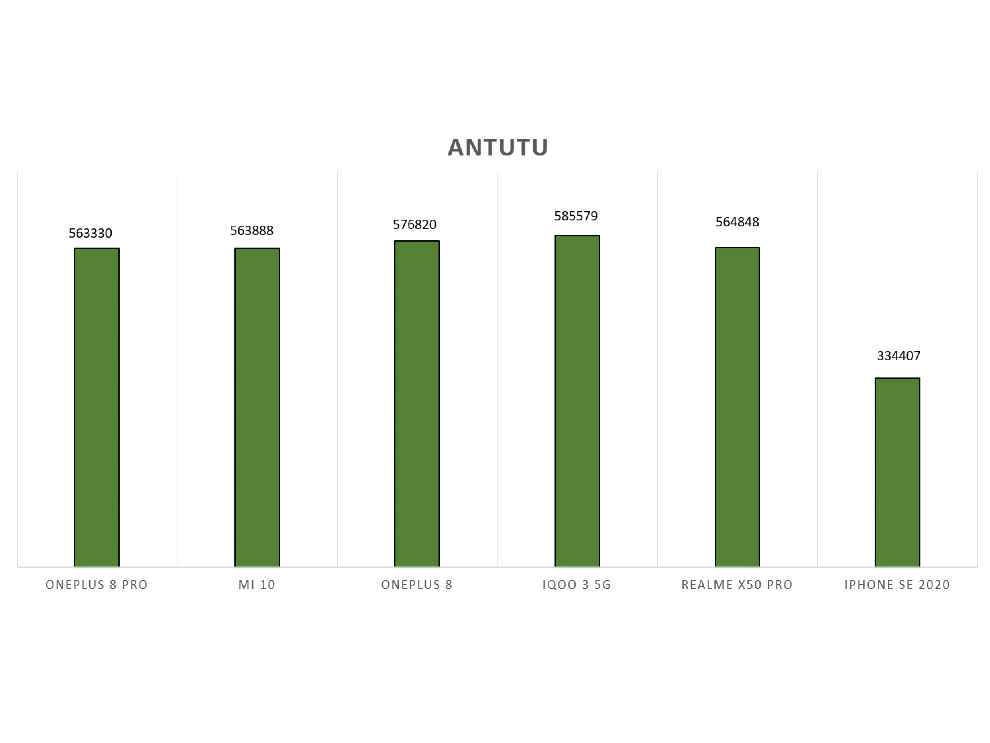
In GeekBench 5 CPU tests, the OnePlus 8 got a single-core score of 914 points and 3358 points in multi-core tests. Here again, the phone leads the scoreboard along with iQOO 3.
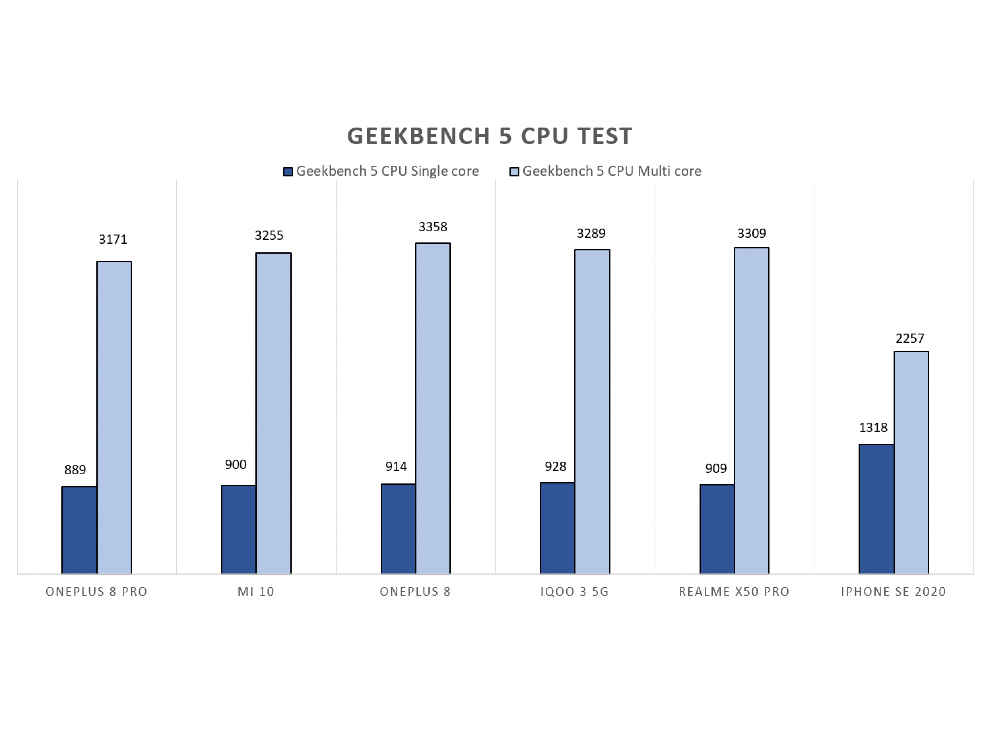
We found similar results when we ran the 3D Mark Slingshot Extreme test on the phone which awarded it 7243 points in OpenGL tests and 6704 points in Vulkan tests.
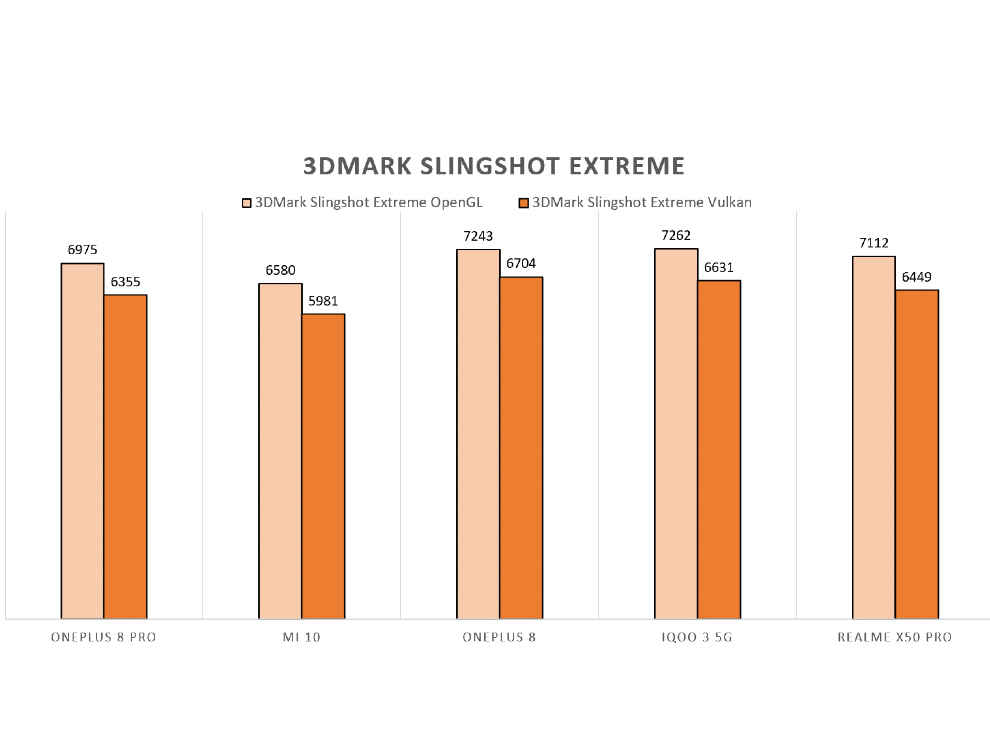
As it stands, the OnePlus 8 is a supremely powerful phone when it comes to sheer raw power as it is around 22-24 per cent more powerful than the OnePlus 7T. This also means that you can expect a steadfast performance from OnePlus 8 in the long run and it wouldn’t disappoint.
Gaming Performance

With the OnePlus 8 running on the latest Snapdragon chip under the hood, there’s no question of the chip to falter when running existing gaming titles. It does it all without breaking a sweat and it is a delight to play games on the OnePlus 8.
For our brief test, we played a couple of rounds of PUBG Mobile, Call of Duty: Mobile, Forza Street and LifeAfter to get a sense of how the OnePlus 8, with all its might, performs when running some graphic-intensive titles. We recorded the performance metrics using GameBench and all the games ran without any apparent hiccups.
The phone was able to run COD Mobile and PUBG Mobile at 60FPS with 95% stability with the prime core rarely being used during the gaming session. It’s just how OnePlus has optimized its software with the hardware as the CPU never reaches its full potential because there’s just no use for it to power through apps and games because the other seven cores are able to deliver a sustained performance which goes a long way in ensuring the longevity of the phone.
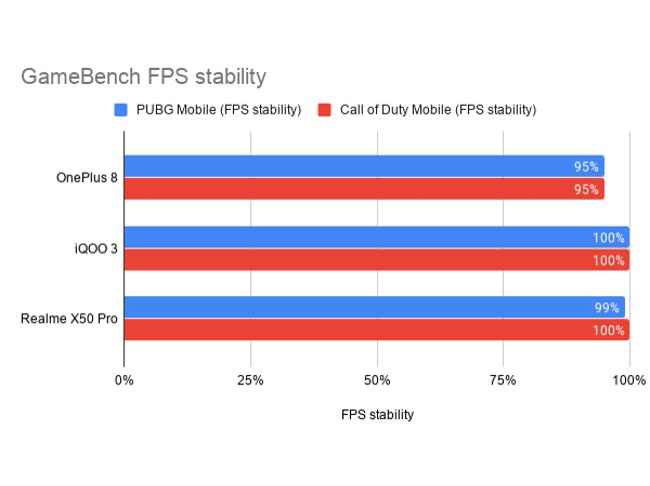
You can read more about our comprehensive gaming test of the OnePlus 8 Pro where we also compare it against the iQOO 3 and Realme X50 Pro.
Software Performance
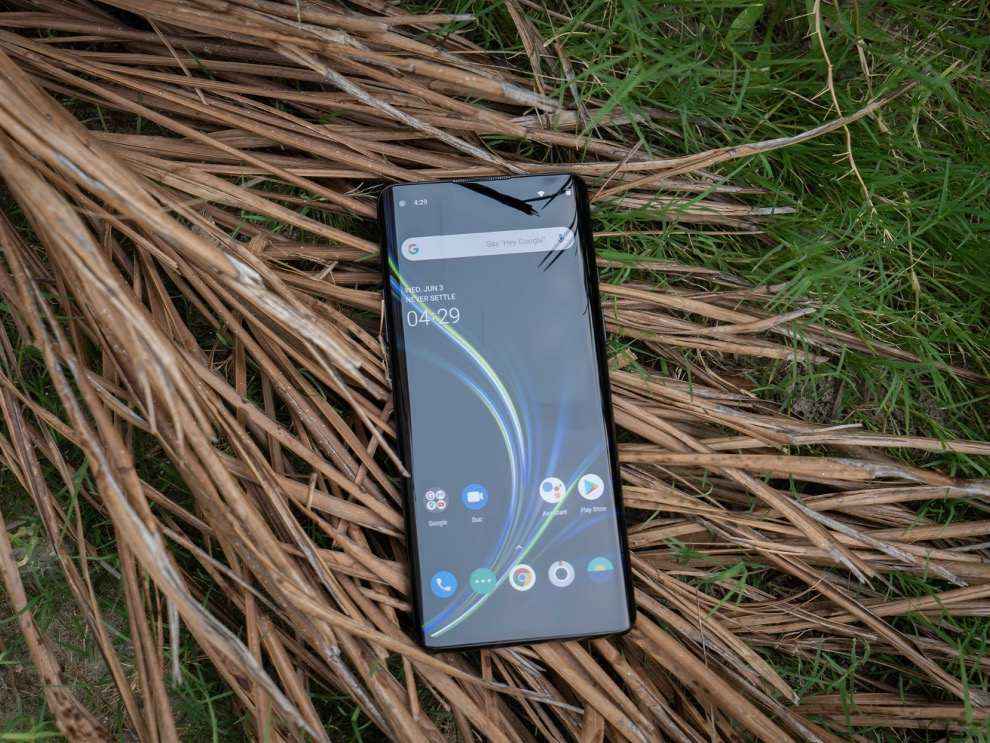
OnePlus 8 runs on OxygenOS 10 which is arguably the cleanest Android UI out there in the market. There are no pre-loaded bloatware apps, other than a generous set of Google apps and the whole user interface looks a lot refined right out-of-the-box. The smooth experience that you get is also a result of system-level optimisations and the 90Hz refresh rate that irons out every animation, transition, scrolling and makes it a fluid phone to use.
The gesture navigation offered by Android 10 ties-in well with OxygenOS letting you interact with the screen with ease. The UI also offers tons of customisations options along with a dedicated work mode profile, dark mode, zen mode and more. It’s also efficient in the way it allows users to multitask easily and features like RAM Boost keeps apps in the background ready for you to resume using it. With the OnePlus 8, the OxygenOS feels like a very refined, no-frills version of Android that every user can naturally be familiar with it. This is something that most Android smartphone UI’s lack and don’t focus on, which results in poor user experience, especially when you have random advertisements thrown in between.
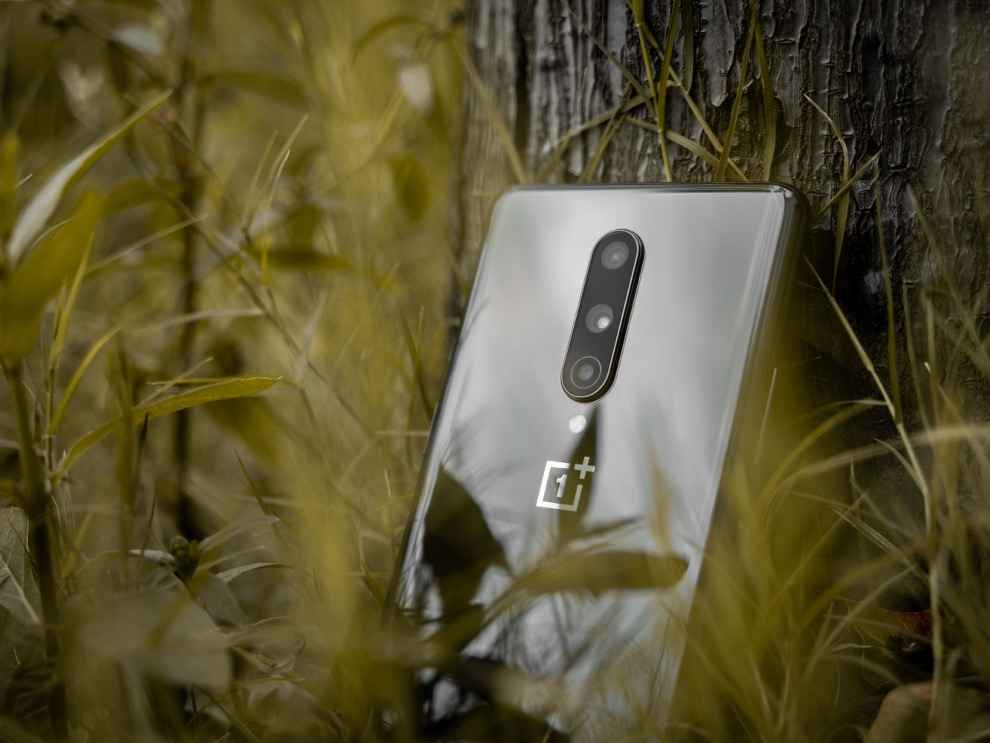
OnePlus 8 remains an underachiever primarily in the camera department, but that’s not to say it comes with bad cameras. It’s just not as versatile as the OnePlus 8 Pro and even the OnePlus 7T which came before it.
It features a 48MP camera that uses the ½-inch Sony IMX586 sensor with an f/1.8 aperture and support for OIS and EIS. This is followed by a 16MP ultra-wide-angle camera with a 116-degree field of view. It trades the telephoto lens from 7T for a 2MP macro camera instead and this is where things get a little confusing. Being a sub-Rs 50,000 smartphone, one would automatically expect flagship-level camera setup but that just isn’t the case here as two of the three cameras are similar to the ones found on older generation OnePlus phones.

The primary camera on the OnePlus 8 is still very good at creating pictures with vivid colours, balanced exposure, excellent details and good dynamic range.

The camera is quick to autofocus and snap a picture in daylight but takes some time processing the shot at night or in low-light environments. While the camera setup is devoid of a telephoto lens, the camera app allows you to digitally zoom into the frame upto 2X by default and it’s pretty decent as well.

There’s a dedicated 48MP mode that lets you create pictures in an 8000 x 6000-pixel resolution but the images often look dull with low saturation across the board. Additionally, it does capture more details than what you’d get with a 12MP-binned picture but the pictures aren’t as sharp as you’d expect.
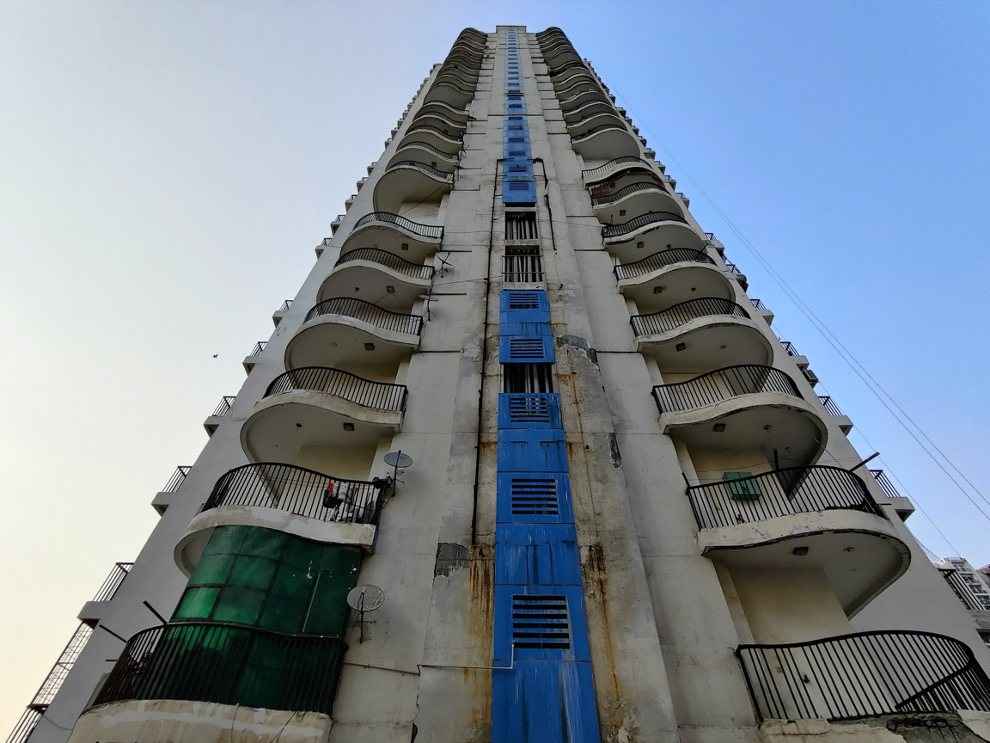
The 16MP ultra-wide-angle camera is capable of filling more elements into the frame and the pictures from this camera came out to be well-detailed and with similar characteristics as the primary sensor. Though we noticed that the pictures often had a higher saturation level than normal with less sharpness around the corners. We’d have liked to see a high-res ultra-wide-angle sensor on the OnePlus 8 as well, but it seems the company saved all the upgrades for the Pro model.

Nevertheless, the ultra-wide-angle camera isn’t half as bad as the macro sensor on the phone. While a macro camera requires you to go up close to the subject to capture intricate details, the 2MP sensor on the OnePlus 8 isn’t capable of producing a well-detailed macro picture. This camera has a narrow plane of focus in the macro mode which makes focusing a bit of a task. The pictures from the macro camera often looked dull without any details and is the most disappointing feature of this phone.
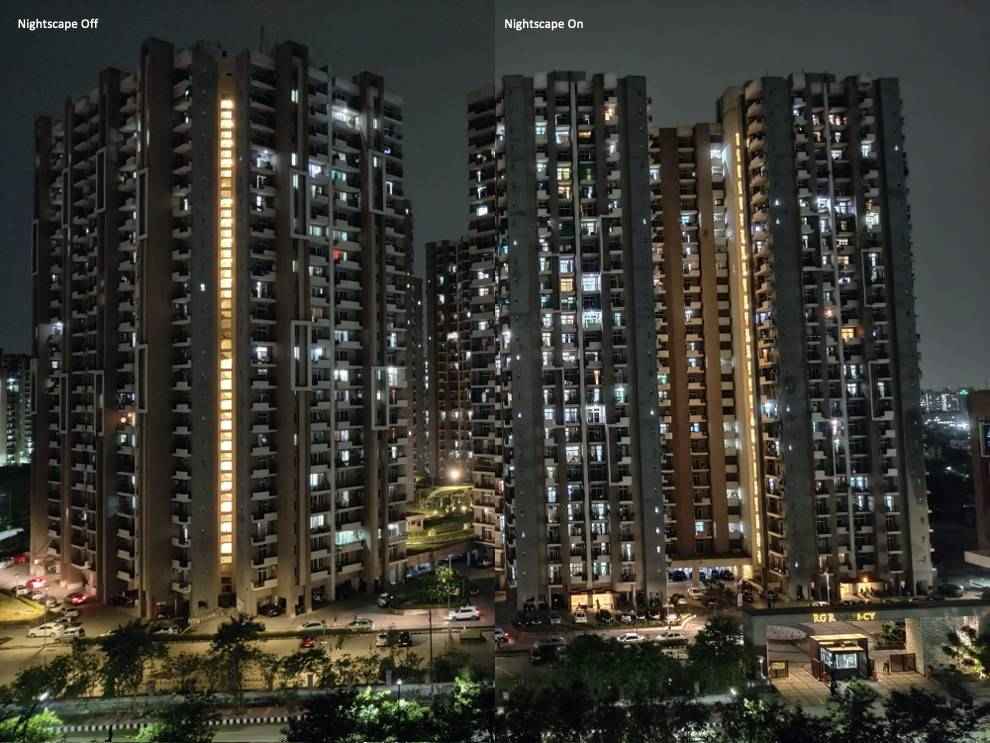
Using the Nightscape mode we were able to get pictures with greater details, though autofocusing behaved erratically at times. Even though the sharpness goes for a toss near the corners as more noise creeps in, the centre area remains in focus and brightens up the scene by a decent margin. The same goes for the ultra-wide-angle camera in Nightscape mode which is better at producing colours and details in low-lit environments.

The OnePlus 8 is capable of recording videos in 4K UHD at up to 60FPS and Full HD at up to 240FPS with support for EIS and OIS. The videos from the primary camera are pretty good and stable for the most part. While recording, the camera is able to maintain the focus instantly which is something that the Pro model lacked as it takes too much time to attain focus on a subject of your choosing. One thing we noticed was that there was no option of switching to ultra-wide-angle camera when shooting videos which is a bummer.
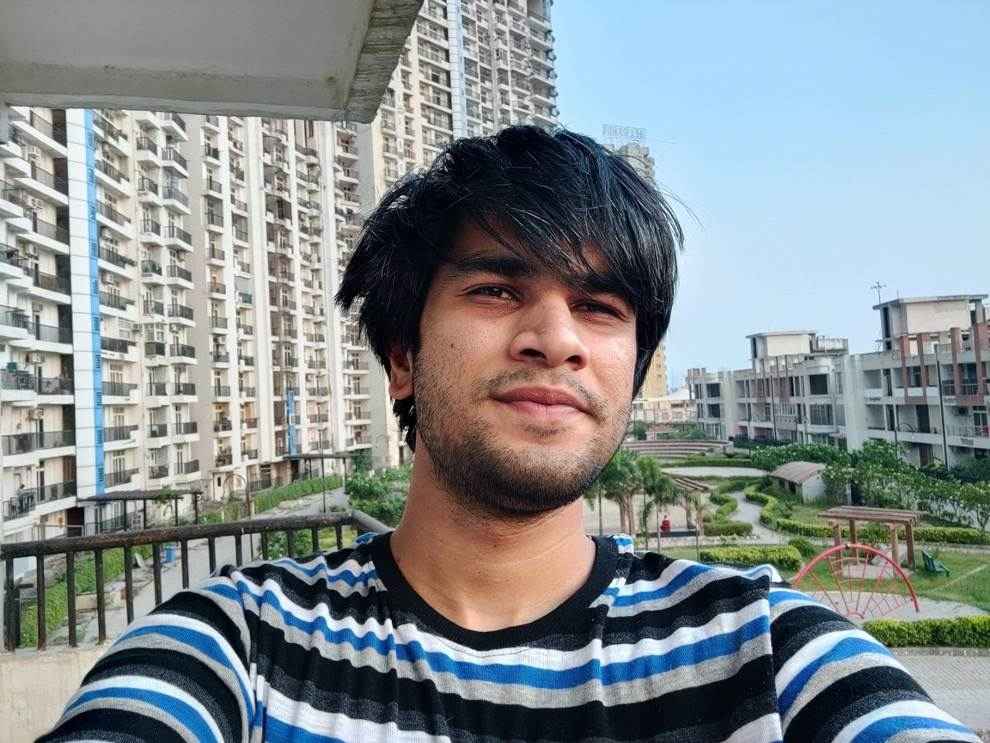
As for the 16MP selfie camera, it creates good-looking pictures in daylight while in low-lit environments the pictures look increasingly processed.
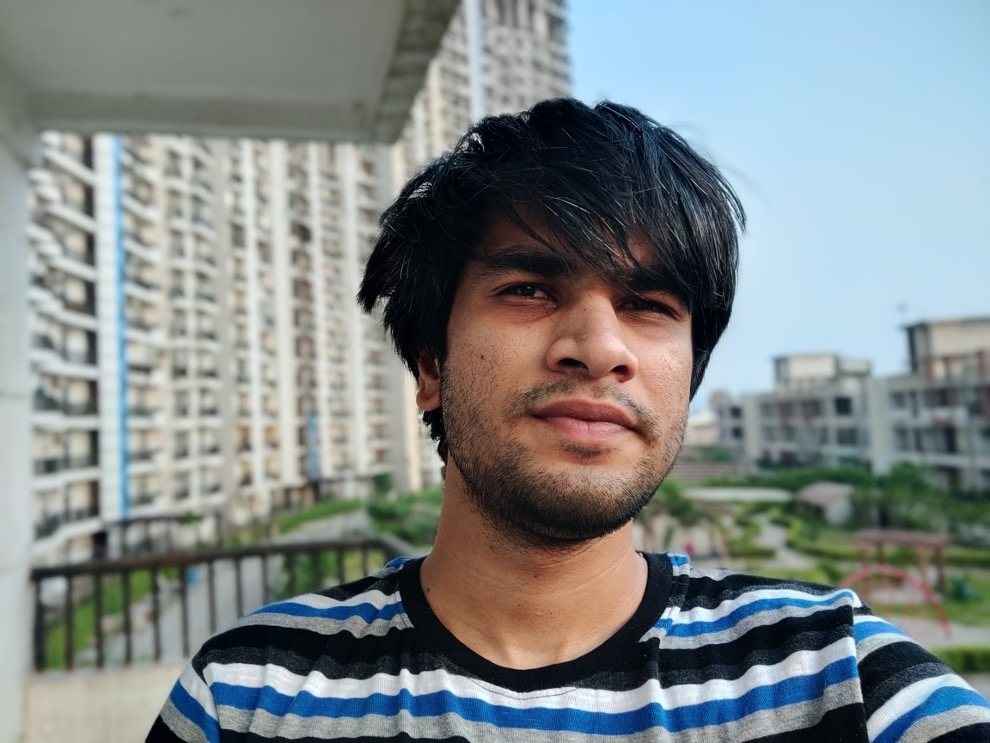
There’s a portrait mode that creates a depth-of-field effect around your face while taking a selfie and it is able to separate the foreground from the background pretty easily.
(Note: The camera samples here are resized for web. You can view the high-res pictures here.)
OnePlus 8 has a 4,300mAh battery that supports 30W fast charging and comes with the Warp Charge 30 adapter in-the-box. The battery performance depends on different use cases and based on my use, the phone is able to last for a full day and sometimes even more than 24 hours on normal use consisting of a lot of social media use, web browsing, listening to music and watching videos in between.
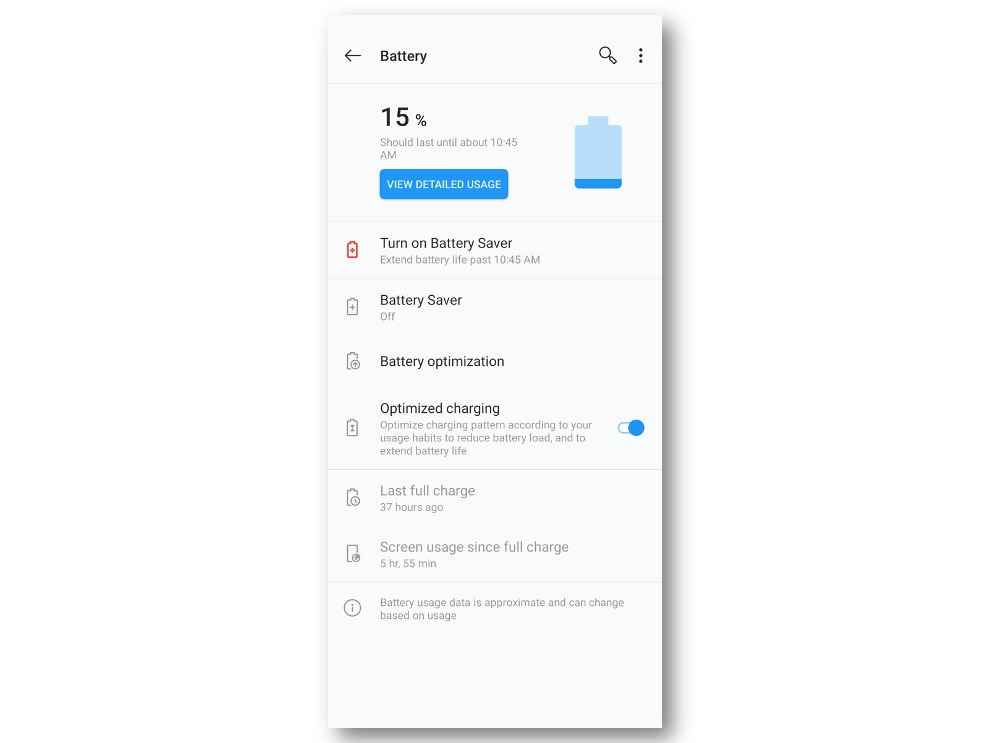
If you’re someone who plays games like Call of Duty Mobile and PUBG Mobile extensively, the phone should still give you a day’s worth of use on a single charge and it’s definitely on the higher side considering the competition.
Surprisingly, in our video loop test, the OnePlus 8 lasted for a full 15 hours on 100 per cent brightness with a three-hour movie running on a loop for the entire time and constant internet connectivity. This is a pretty good result in our books when it comes to battery efficiency especially with the 90Hz refresh rate. The battery took a 7 per cent hit on a 15 minutes session of CoD Mobile, which again is pretty decent.
The phone took 30 minutes to go from 0-50 per cent and 72 minutes to charge fully from 0 to 100 per cent. While it isn’t the fastest fast-charging solution available in the market, you’d just be fine with what the OnePlus 8 offers.

OnePlus 8 features a 6.55-inch display that has a Full HD+ (2400 x 1080 pixels) resolution and uses an AMOLED panel. The screen is HDR10+ certified and has a 90Hz high-refresh-rate which makes everything look buttery-smooth. The display has a peak brightness of 908 nits as measured by our light meter and minimum luminance of 7 nits. This means that the screen can achieve an excellent level of brightness which comes in handy when watching a video or a movie on the phone.
OnePlus has gone with a punch-hole cutout for the front-facing camera this time which gives the screen a 20:9 aspect ratio. It can feel a bit odd when looking at the display for the first time, not so much as the small cutout but rather a black dot in the top corner, but give it some time and your eyes will likely be comfortable with it at the end.
The display is also curved on the sides offering an immersive viewing experience, something that's common with premium flagship phones these days. It has the perfect amount of bend, lesser than the 8 Pro, which makes it comfortable to use with one hand and with gestures enabled. In my use, I did not notice any accidental touch inputs something that's known to be irksome with a curved screen.
The screen on the OnePlus 8 is fairly good at reproducing colours accurately with excellent clarity and has great viewing angles. The sunlight legibility is good too and on par with the competition.
But say for instance you prefer screens with more saturation, OnePlus offers an advanced screen calibration option that lets you tweak the colours between preset options Adobe sRGB and DCI-P3 range. Another thing we noticed was that the curvature of the screen isn't too prominent so you won't be able to notice it when looking directly at it. This adds to the overall experience of interacting with the display.
Another notable thing about OnePlus phones in recent years has to be the biometric security it offers with the in-display fingerprint reader which is able to identify your prints and unlocks your phone in a jiffy.
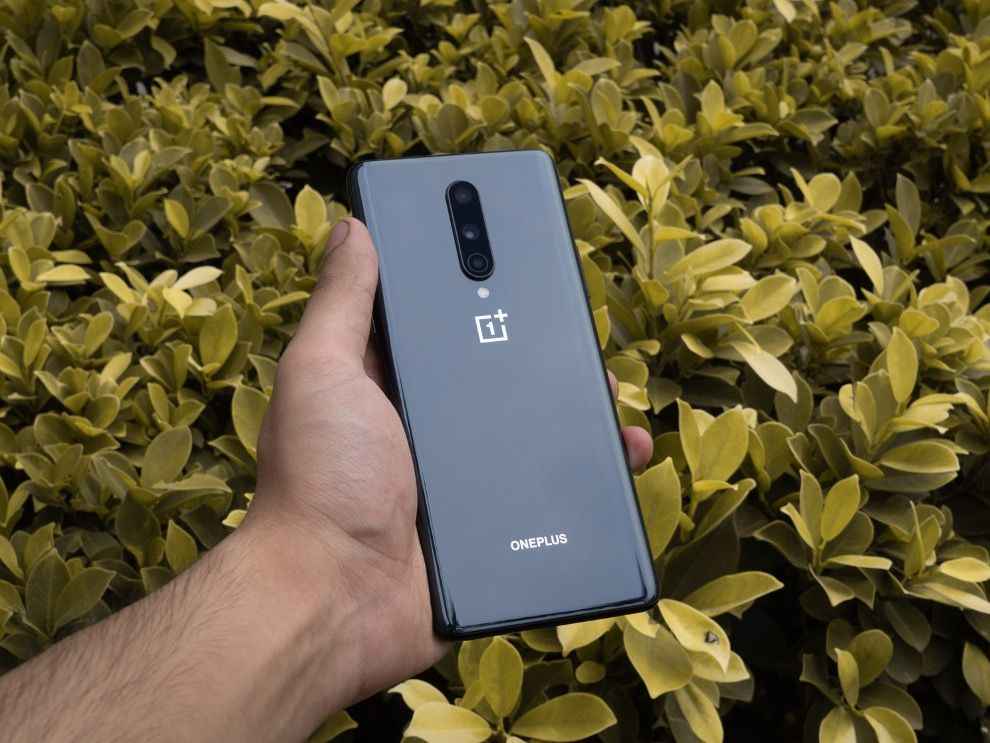
The OnePlus 8 seems to be a very refined smartphone in terms of the design language and is lightweight as well. The phone measures 8 millimetres at its thickest point and weighs in at 180 grams, making it one of the thinnest and lightweight flagship phones to exist right now.
OnePlus 8 comes in three colours-- Onyx Black with a glossy finish, Interstellar Glow with a reflective finish and Glacial Green with a matte finish. Naturally, the black and Glow colour variants are prone to smudges a lot more than the matte version.
It is quite handy to use for day-to-day activities and at no point did the size or weight come across as a hurdle in the overall experience. The OnePlus 8 is built using aluminium chassis slapped with Gorilla Glass 5 on both sides making it durable and comfortable when in the hand.
The conventional candy-bar design just seems refreshing and comfortable to hold with its rounded corners along with a display that just perfectly tapers a bit on the edges. OnePlus offers a transparent case in-the-box which fits just perfectly on the phone with big and bold "Never Settle" written across. It doesn't look odd as it's only visible from certain angles and the best part is that it doesn't add to the weight of the phone. In my use with the case put on, the phone came unscathed after a couple of drops to the marble floor.
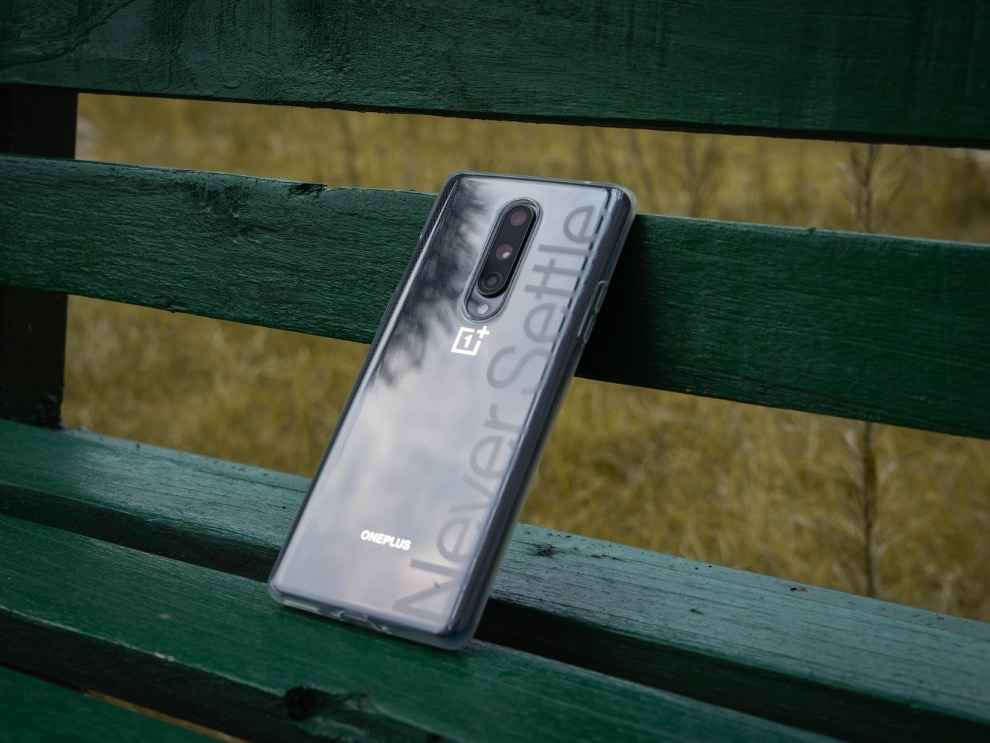
You'll find the alert slider and power button on the right edge and the volume buttons on the left. These buttons are fairly tactile and can be easily reached with one hand. There's a USB Type-C port at the bottom along with the SIM card slot and a speaker unit.
OnePlus 8 doesn't come with an official IP certification in India, however, the same phone has received an IP68 rating when bought in-contract from the US. The missing certification is likely a cost-cutting decision and the phone you get in India offers the same ingress protection, even though it's not officially certified.

OnePlus 8 nails the essentials which makes it a pretty well-balanced offering from the company. Notwithstanding the unsettled camera performance, it remains a powerful performer with the smoothest Android experience currently available in the market. The display on the OnePlus 8 is great for watching videos and binge-watching Netflix. The battery life of OnePlus 8 is great too and if not better, it’s at least on par with the competition.
So, if you’re not that critical about getting a versatile pair of cameras on your smartphone, the OnePlus 8 can be considered as a viable option as it offers you a no-frills Android experience and is a phone you can depend upon starting at Rs 41,999.
Sure there are alternatives like the Realme X50 Pro and the iQOO 3 that offer a versatile set of rear cameras but the overall experience of the OnePlus 8 remains unmatched.
| Price: |
 Rs. 41999
Rs. 41999
|
| Release Date: | 14 Apr 2020 |
| Variant: | 128GB8GBRAM , 256GB12GBRAM |
| Market Status: | Launched |
 Screen Size
Screen Size
 Camera
Camera
 Memory
Memory
 Battery
Battery

Digit caters to the largest community of tech buyers, users and enthusiasts in India. The all new Digit in continues the legacy of Thinkdigit.com as one of the largest portals in India committed to technology users and buyers. Digit is also one of the most trusted names when it comes to technology reviews and buying advice and is home to the Digit Test Lab, India's most proficient center for testing and reviewing technology products.

We are about leadership-the 9.9 kind! Building a leading media company out of India.And,grooming new leaders for this promising industry.

55
59
55
65
The Intex Q11 is a sub-par smartphone in all respects. It fails in terms of performance, camera and almost everything else. We would recommend spending a little more, to buy the Xiaomi Redmi 3s.
Smartphone makers have been relentlessly innovating in the budget segments. Unfortunately, the innovations we’ve seen in the sub-20K or sub-15k segments haven’t yet trickled down to phones that cost even lesser. To be precise, most sub 7K smartphones still feature 2-year-old hardware and negligible performance boosts compared to last generations. So, when the Intex Q11 4G was dropped off at my desk, I was a tad unsure about how it would fare. Frankly speaking, the phone doesn’t seem very competent on paper.
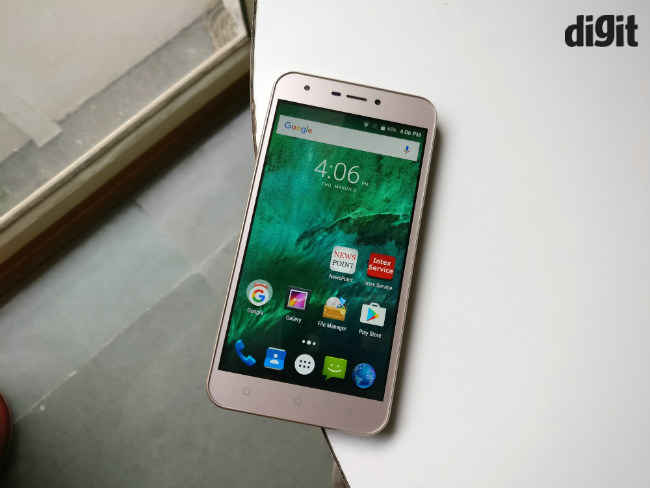
Interestingly, its main feature is the VR capabilities built into it. But, we’ll get to that later. For now, let’s begin with the look and feel.
Build and Design
The design and build quality of the Intex Q11 4G is pedestrian. The glossy back on the phone feels odd and somewhat cheap. It also looks low-end, but seems sturdy enough, considering the price. There’s a certain heft to it and even though the surface looks fragile, it’s not easily scratched, and can withstand an occasional knock or two. Intex does provide an additional clear-case and screen protector in the box, but I believe there’s definitely room for improvement.
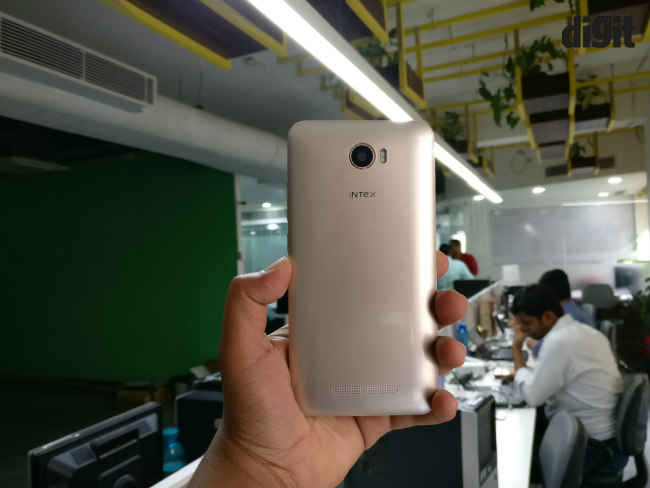
Beside the two physical power and volume rocker keys, there is a silent toggle on the left side of the phone. All three physical keys work as intended, but they don’t respond at times. Also, the buttons feel shallow, as they would if the phone was inside a case.

Also, the phone looks like a carbon copy of the Intex 5.5VR smartphone, which was launched a few months back. The two devices share features as well.
Display and UI
Even the displays on the two devices are the same. The 5.5-inch screen on the phone seems quite good, considering the price. Touch response is wonky, though, it’s more like a hit and miss at times. It works sometimes and at others, takes more than a single tap.
Slow performance makes the sub-par touch performance feel worse, which I shall explain in the performance section. The colour reproduction is quite good, but again, viewing angles are just about average. Sunlight visibility isn't great either and there is a visible colour shift from not so wide angles.
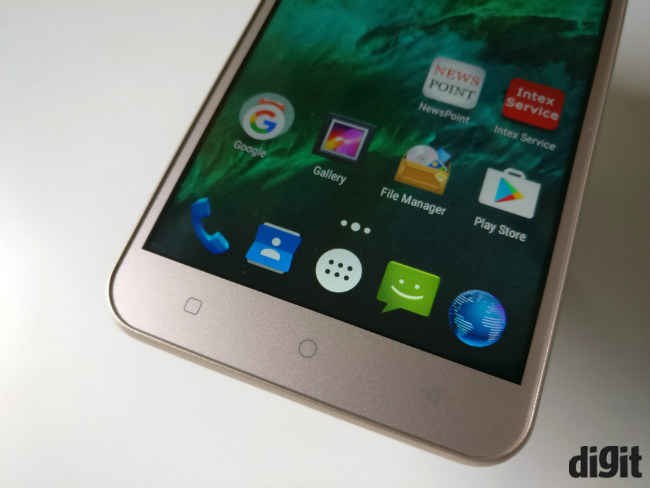
The UI remains the same as well. It bears a stock like facade, which is then integrated into an advert-ridden ecosystem. There are almost a dozen pre-loaded apps, most of which can't be uninstalled. The camera app has shortcuts to a shopping app and editing app. Intex’s own app aggregator will also keep popping up on the device’s notification panel and can be dismissed only after you open it and install a few apps. If you don’t want to, you just have to live with it.

The leftmost homescreen include some weather and current news info from partner apps. While some may like this, and it works as intended, all this together makes it seem like the phone is made primarily to sell apps, rather than providing a good experience.
Performance
The performance of the phone was quite disappointing too. Firstly, there isn’t enough space on, with only 8GB of internal storage. With less than 4GB available to the user, the phone refused to install my regular set of test applications. Further, thanks to Intex’s app aggregator, I ended up installing more unwanted apps, which I then uninstalled.
Interestingly, the phone does not handle apps well either. It lags in simple navigation tasks, like opening recent tabs. This is partly due to the fact that it has only 1GB of RAM and partly because the UI lacks optimisation. It became quite apparent, as simpler games, such as 32 Secs hung a couple of times, when it was the only active task. While the phone does manage to run apps such Facebook, Gmail and Chrome, the experience here is sluggish.
VR is supposed to be a redeeming feature here, and while it does run, it’s not flawless. You can play 360 degree videos via YouTube or watch a pre-loaded videos, but that’s pretty much it. The gyroscope often loses alignment and there isn't much space to install VR games either. Here are some synthetic benchmarks, which do not truly justify the phone’s performance in day-to-day performance.
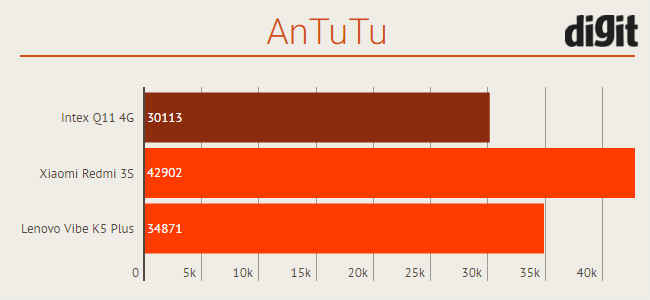
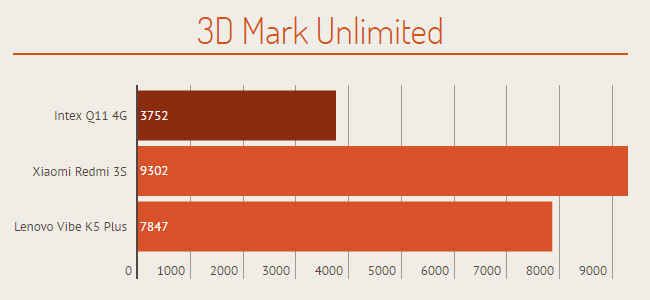
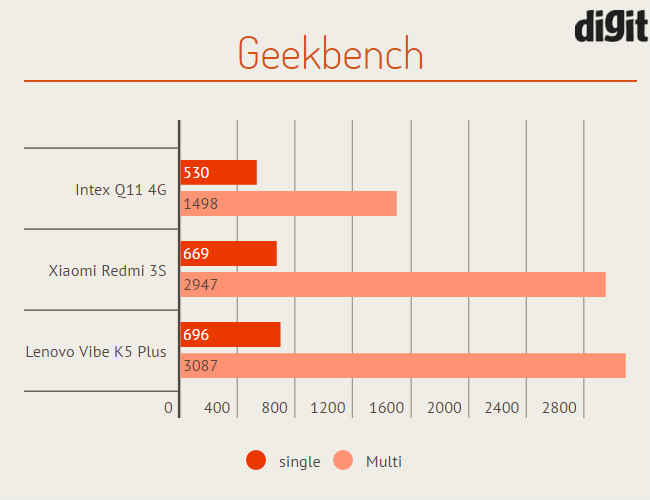
Given its performance otherwise, it’s confounding why Intex wants to sell it on VR capabilities. While lower tier markets may not be privy to things like the Samsung Gear VR (which are not perfect either), this is not the first taste of VR that you should get.
Battery
The PC Mark battery test returns 7 hours and 23 minutes of battery life, which is the industry average today. Using the phone as a daily driver with a Jio SIM, it made it through a normal work-day with over half a dozen calls, about an hour of video streaming, and heavy Facebook and browser usage.
I didn't game much on the device, though, due to unplayable frame rates. Looking past that, there was a drop of 18% in an hour of gaming, with Breakneck.
At one time, while testing the device, it was showing wrong info about the remaining battery percentage. The battery percentage dropped from 30% to 14% suddenly, and then went back up to 35% in the span of less than a minute. This could be an UI issue, or may even be a sign of larger problems. Regardless, it’s not something you want on a phone you just bought.

Once discharged, the 2800mAh removable battery takes about 4-5 hours to charge back, which is inconvenient.
Camera
The 8MP rear shooter is again sub-par. Images taken during daytime are dull, lack details and have softer focus, which ruins image all together. Colour reproduction is way off the mark and dynamic range is poor. This also means the camera is unable to process different shades of the same colour properly. As a result, objects lose appeal and pictures lose composure. Image quality further deteriorates as you move indoors and under low light. Under fluorescent light, images appear hazy, with softer focus. Photos are underscored by low details and visible noise. Low light images are almost unusable.
View post on imgur.com
Bottomline
The Intex Q11 4G is a sub-par phone, despite its low price. Its performance is inadequate, the UI is irritating, the camera is unsatisfactory and build quality and design are pedestrian. It’s VR elements aren’t flawless either. I would suggest you raise your budget to about 7K and get the Xiaomi Redmi 3S, which is a much better phone than this.
| Price: |
 Rs. 7800
Rs. 7800
|
| Release Date: | 25 Jan 2017 |
| Variant: | 8GB |
| Market Status: | Launched |
 Screen Size
Screen Size
 Camera
Camera
 Memory
Memory
 Battery
Battery

Light at the top, this odd looking creature lives under the heavy medication of video games.

Digit caters to the largest community of tech buyers, users and enthusiasts in India. The all new Digit in continues the legacy of Thinkdigit.com as one of the largest portals in India committed to technology users and buyers. Digit is also one of the most trusted names when it comes to technology reviews and buying advice and is home to the Digit Test Lab, India's most proficient center for testing and reviewing technology products.

We are about leadership-the 9.9 kind! Building a leading media company out of India.And,grooming new leaders for this promising industry.

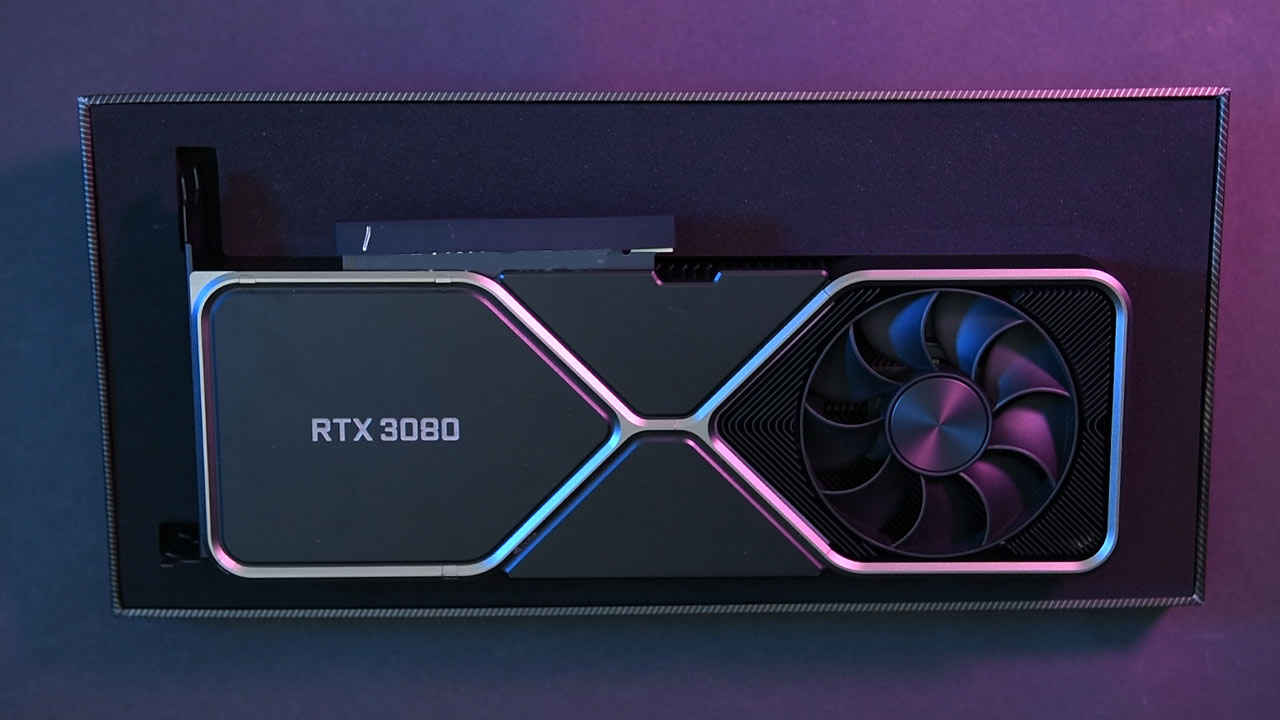
The NVIDIA GeForce RTX 3080 easily beats the RTX 2080 across all games and synthetic benchmarks by about 30-70 per cent. In some titles, it events goes ham and achieves 2x the performance. So there's little need to worry over there. It's even cooler than previous gen reference cards. So there's little reason to skip this generation. If you're looking for a flagship GPU to own, this is it. We're still going to wait for the AMD RDNA GPUS in the form of the RX 6000 series but by the looks of it, AMD has a tough job if it wants the performance crown.
| Price | 71000 |
After two whole years, we're looking at the next major GPU launch cycle with NVIDIA Ampere RTX 30 series and AMD's RDNA2 RX 6000 cards right around the corner. During launch, NVIDIA CEO showcased the new Ampere cards while claiming 2x performance and 1.9x greater performance-per-watt over the older Turing RTX 20-series cards. We're going to be looking at the RTX 3080 today since that's the first Ampere card to be launched with the RTX 3090 coming within two weeks from now and the RTX 3070 coming later in October. At Rs 71,000 it has the same launch price as the RTX 2080, the RTX 3080 doesn't have to convince gamers. It supposedly even beats the RTX 2080 Ti which costs a lot more but by what margin? Let's figure that out.
The specifications for the three RTX 30 cards when compared to their RTX 20 counterparts let you know exactly how they are positioned. With 24 GB of memory, the RTX 3090 is akin to the RTX TITAN and would be targeted at workstations and multitasking machines which require a lot of CUDA cores. Whereas, the RTX 3080 and RTX 3070 are very much similar to the RTX 2080 and RTX 2070 in terms of positioning. Which bears the question, what's the equivalent for the RTX 2080 Ti? It would appear that NVIDIA is holding back till AMD's RDNA2 "Big Navi" cards are released in November 2020. We should hopefully see RTX 3080 Ti or Super cards that equal or beat the RDNA cards as a reaction to AMD's cards.
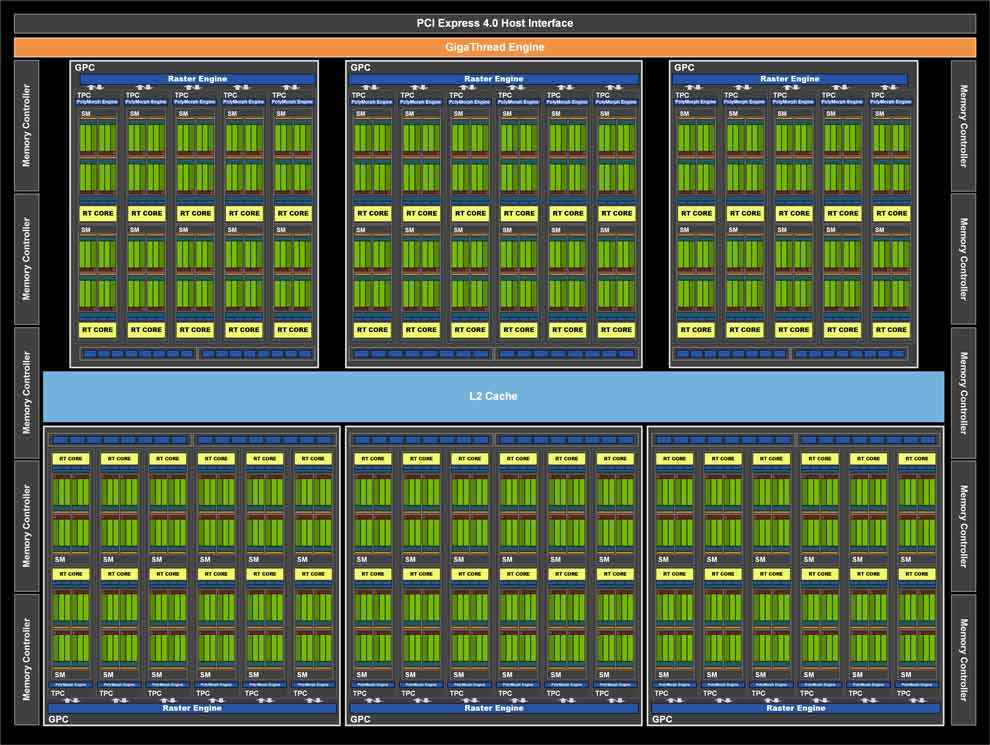
The RTX 3080 in particular has 8704 CUDA cores if you look at how the SMs have been completely revamped compared to Turing. We have six GPCs within the GA102 GPU for the RTX 3080 but there's asymmetry with the GPC configuration. There are 4 GPCs which have 12 SMs each and there are two GPUs with 10 SMs in them. Overall, we're looking at 68 SMs with a total with 8704 CUDA cores in all.
We have featured some of the GTX 10 series cards along with most of the RTX 20 series cards including the Super cards. A few AMD RX 5000 series cards were also thrown into the mix to see how good the cards perform against the competition. With AMD’s Big Navi around the corner, it’ll be great to see how these RTX 30 cards and RDNA2 cards go up against each other. Like always, we have a section for synthetic benchmarks as well as gaming benchmarks with plenty of charts to showcase differences. Coming to the rig, this is what we’re running our benchmarks on.
Processor - Intel Core i9-10900K
CPU-Cooler - Noctua NH-D15
Motherboard - ASUS ROG MAXIMUS XII EXTREME
RAM - 2x 16 GB Corsair Dominator Platinum @ 3200 MHz
SSD - Kingston KC2500 1TB + WD Blue 1 TB
PSU - Cooler Master V1200
Graphics cards:
RTX 3080
RTX 2080 Ti
RTX 2080 Super
RTX 2080
RTX 2070 Super
RTX 2070
RTX 2060 Super
RTX 2060
GTX 1080 Ti
GTX 1080
AMD RX 5700 XT
AMD RX 5700
AMD RX 5600 XT
Some of these cards were sourced from friends owing to the fact that the current lockdown situation has made it extremely difficult to get graphics cards in time for the benchmarks. Let's start with the synthetic benchmarks.
3DMark
In 3DMark, we prefer the Fire Strike Ultra benchmark since the Extreme and normal runs have started producing ridiculous scores with newer GPUs. The other benchmark within 3DMark which we use is Time Spy and we run both, the normal run and the extreme run. Here, we’re showcasing Fire Strike Ultra and Time Spy scores. The RTX 3080 scores 10959 in 3DMark Fire Strike Ultra which puts it 68.4 per cent ahead of the RTX 2080 and 35 per cent ahead of the RTX 2080 Ti
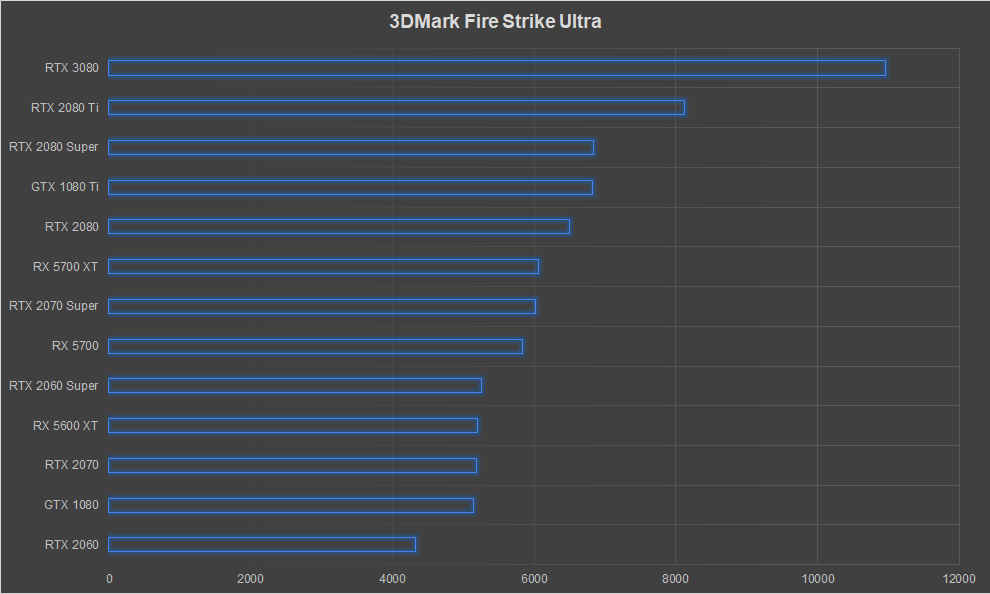
Time spy shows a slightly conservative figure with a 54.5 per cent lead over the RTX 2080 and a 30 per cent lead over the RTX 2080 Ti. Did we say conservative? We should have said “relatively conservative”.
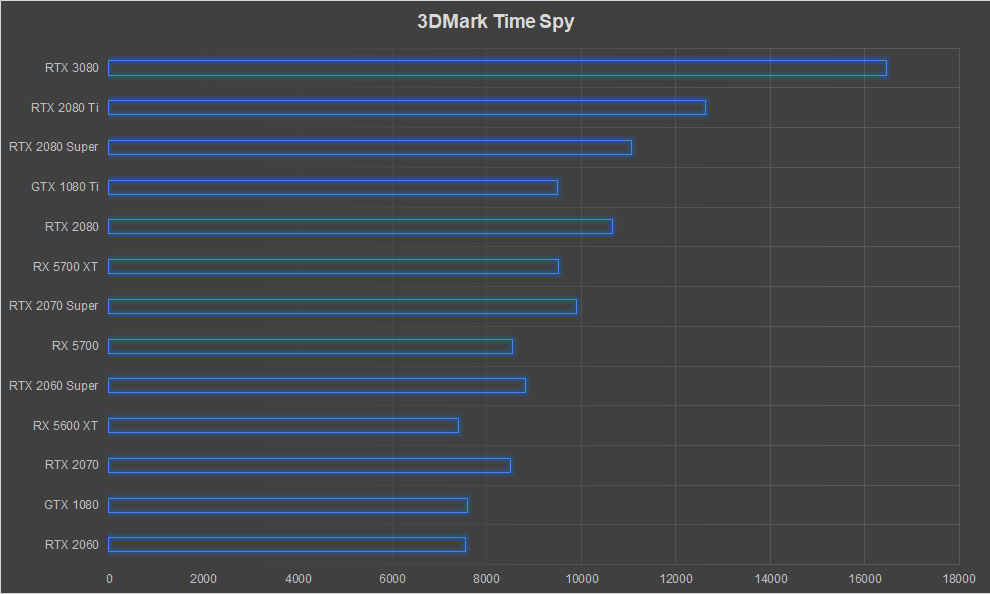
Basemark GPU
Basemark GPU is a nice benchmark to compare the performance of different graphics APIs between cards. We can use the same textures with OpenGL, Vulkan and DirectX 12 to see if the graphics card excels at any particular API more than the rest or if the performance is consistent across the board. The RTX 3080 achieves scores that are between 66-81 per cent greater than the RTX 2080 and about 26-31 per cent greater than the RTX 2080 Ti. Surprisingly, Ampere’s OpenGL performance has improved the most with DX12 coming in at second and Vulkan bringing in the rear.
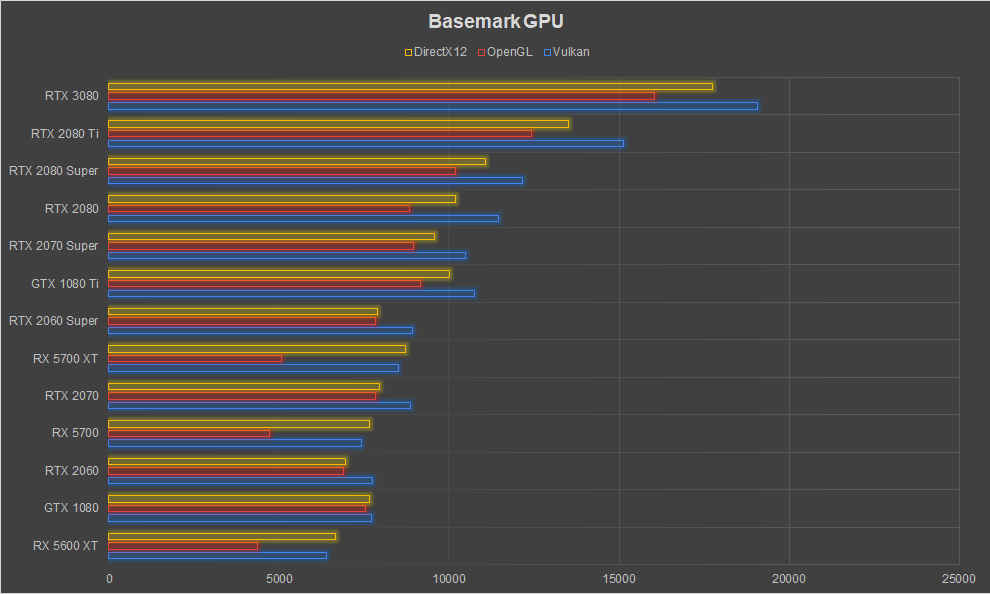
Blender
Blender is a great 3D modeling and animation software that’s open-source and it is the preferred tool for folks wanting to get their hands dirty with 3D modeling. We use version 2.8 to keep up with legacy scores that we have for older cards. The latest stable version would be 2.9 and it’s an incremental upgrade. We use the classroom scene since that’s capable of utilising the GPU for rendering the scene aside from the CPU. The RTX 3080 finished the scene in 1m 18s which is a decent 4 seconds lesser than the RTX 2080 Ti. As for the RTX 2080, it renders the scene in about 94 seconds so that’s a 16 second lead for the RTX 3080.
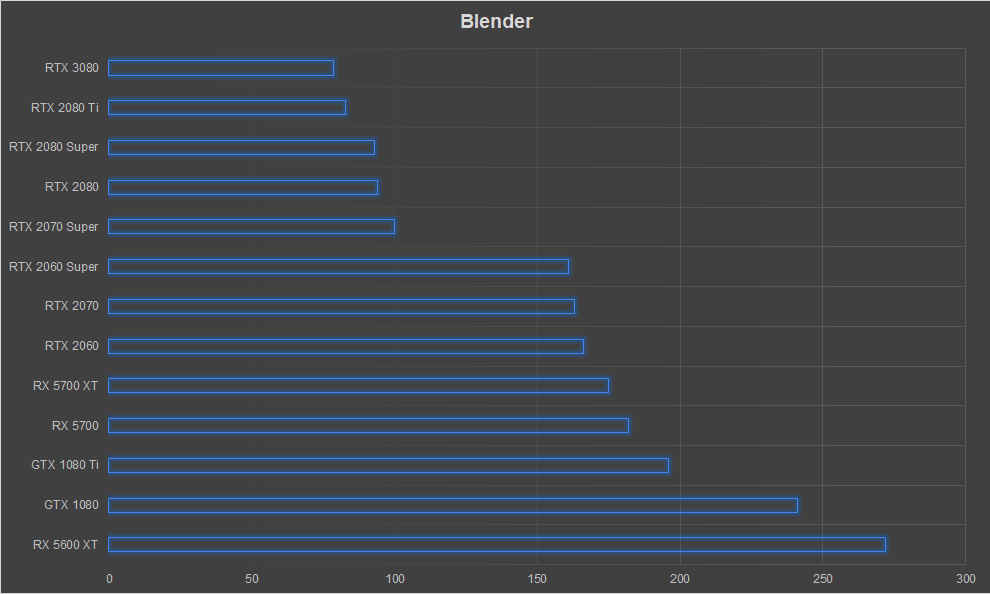
IndigoBench
This is the latest synthetic to be added to our test suite. IndigoBench is based on the Indigo 4 rendering engine that’s available for popular software such as SketchUp, Blender, 3ds Max, Cinema 4D, Revit and Maya. It uses OpenCL and can benchmark both, the CPU and GPU together or individually. We prefer to test just the GPU with the software and the score provided is in terms of .M samples/s’. The RTX 3080 clocked in at 35.751 M Samples/sec which is about 18.9 per cent more than the RTX 2080 Ti and 56.4 per cent more than the RTX 2080.
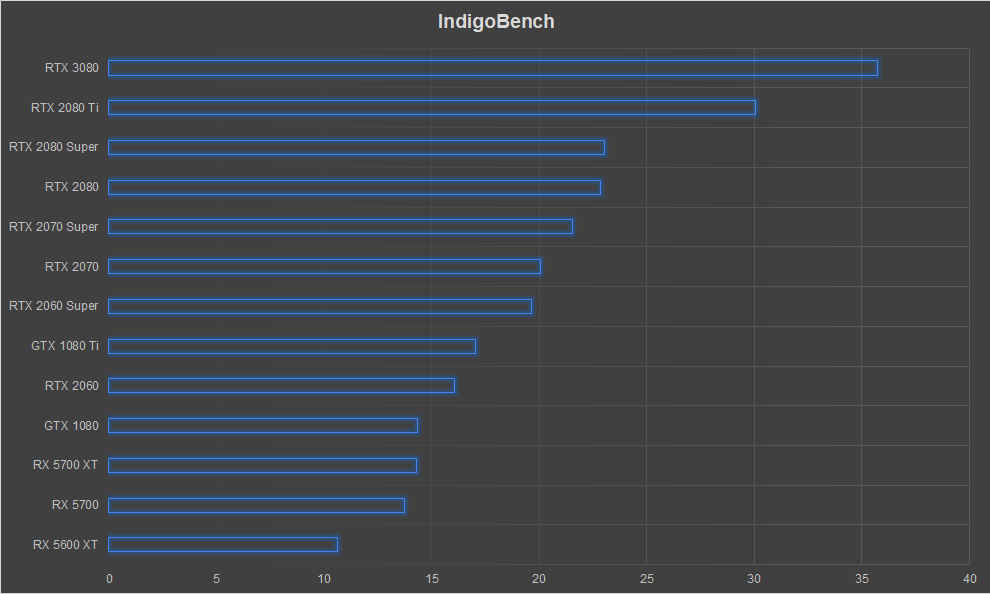
Unigine SuperPosition
Unigine SuperPosition is the other popular DX11 benchmark which we prefer to use alongside 3DMark. We run it on the Extreme Quality preset and use the score metric for delineating the performance between graphics cards. The RTX 3080 performs 17.5 per cent better than the RTX 2080 Ti and 49 per cent better than the RTX 2080.
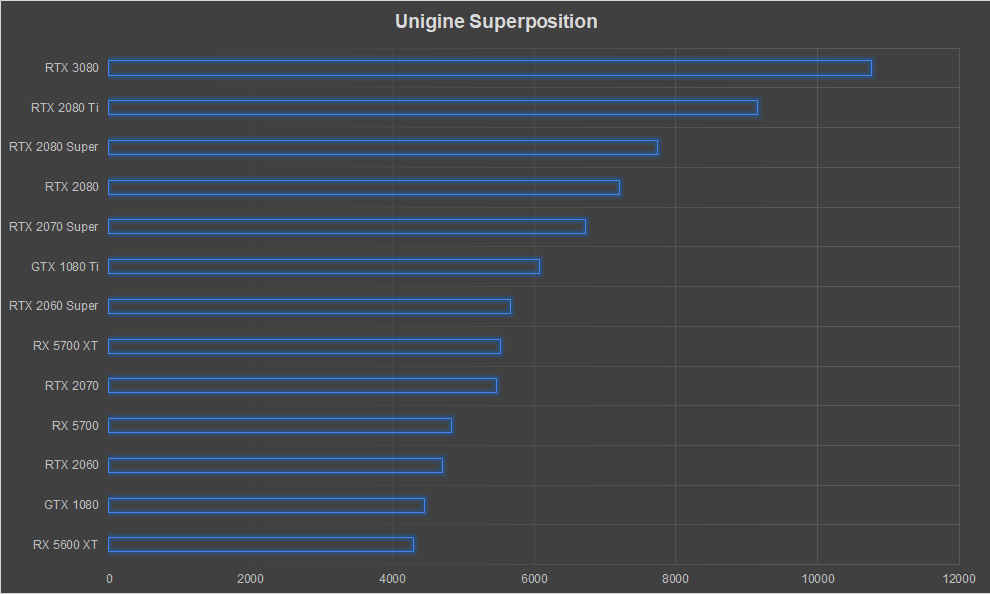
Borderlands 3
Gearbox’s latest game in the Borderlands franchise which uses Unreal Engine 4 and allows you to switch between DirectX 11 and 12. The game has an inbuilt benchmark which takes you through an array of stressful scenarios. The DirectX 12 version is quite flaky and we prefer to use the DirectX 11 API while benchmarking the game and all our existing data is based off the DX11 version so there’s no point switching now. In Borderlands 3, the RTX 3080 performs about 25-28 per cent better than the RTX 2080 Ti and about 56-58 per cent better than the RTX 2080. This is a pretty sizable jump in performance.
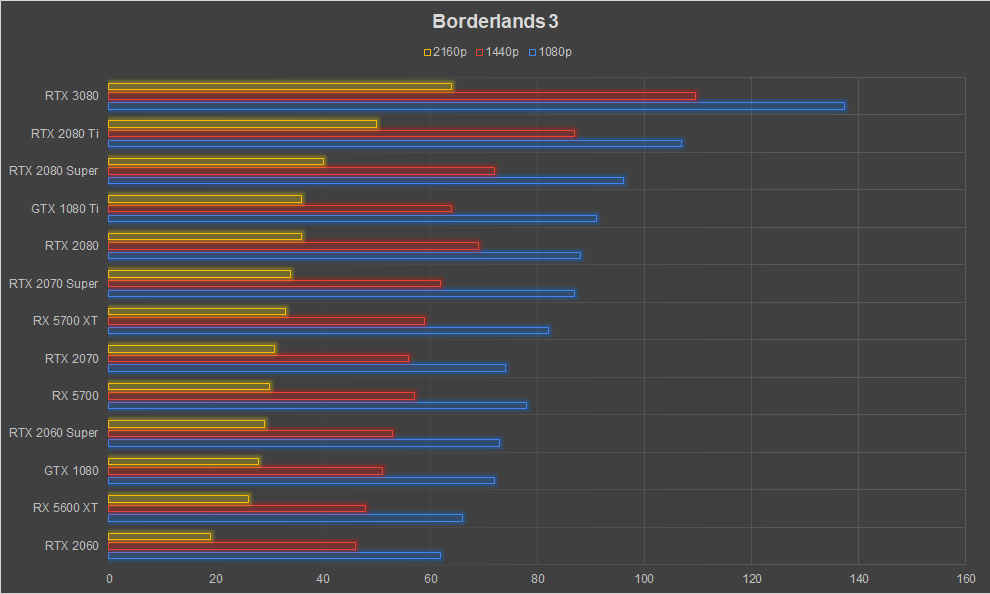
Death Stranding
Hideo Kojima’s Death Stranding has been a recent addition to the PC scene and had been a PlayStation exclusive until July 2020. Being a console game, the game engine is quite optimised to make use of the scarce resources one gets with consoles. However, when 505 Games ported the game to PC, you wouldn’t end up calling the game a console port. The Decima game engine is capable of rendering up to 4K and can use high dynamic-range imaging and is also geared for the upcoming next-gen PlayStation console. It’s also the same engine used by Horizon Zero Dawn. We saw the RTX 3080 perform about 23 per cent better than the RTX 2080 at 1080p and 1440p and about 11-15 per cent better than the RTX 2080 Ti.
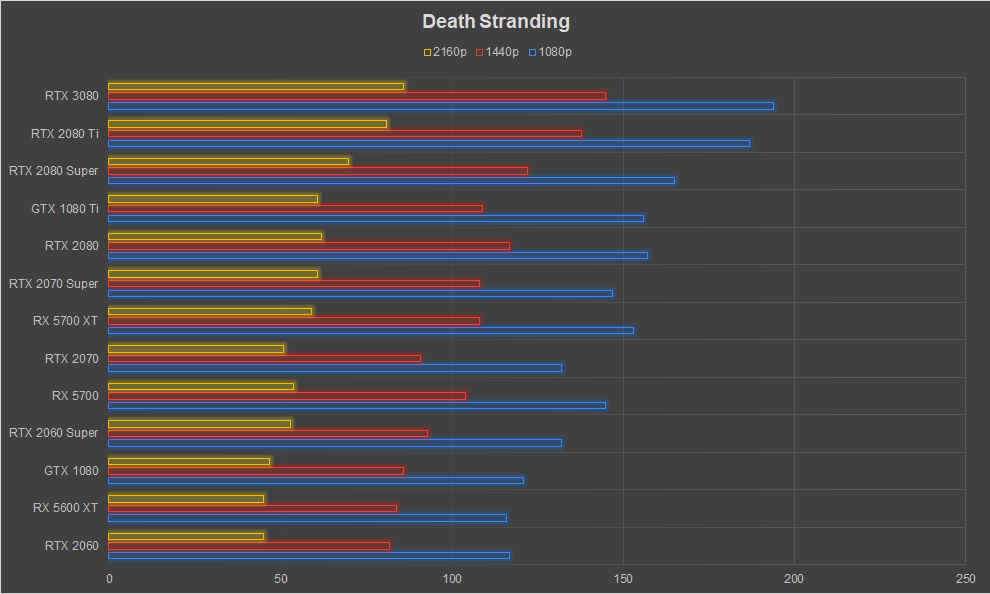
Doom Eternal
Doom Eternal takes the story forward from the 2016 DOOM and it does it in spectacular fashion. It’s also one of the new games to incorporate ray-tracing as an update. The game is based on the latest Id Tech 7 game engine from Bethesda and is tremendously optimised for current gen hardware. Unlike the previous DOOM which allowed you to choose between DirectX and Vulkan, Doom Eternal is locked to Vulkan and makes use of RTX to level-up the ingame visuals. We keep the FOV at default with all the other graphics settings cranked up to Ultra Nightmare. Motion Blur is switched off across all runs because it takes away from the visual fidelity and makes running a benchmark kinda pointless. Performance metrics for Doom Eternal put the RTX 3080 a good 2x over the RTX 2080 and 1x over the RTX 2080 Ti. And we’re talking 4K here. With 1080p resolution, the FPS values are so high that the difference isn’t clear. We averaged a 57 per cent improvement over the RTX 2080 at 1080p. And compared to the RTX 2080 Ti, it was 30 per cent better at 1080p.
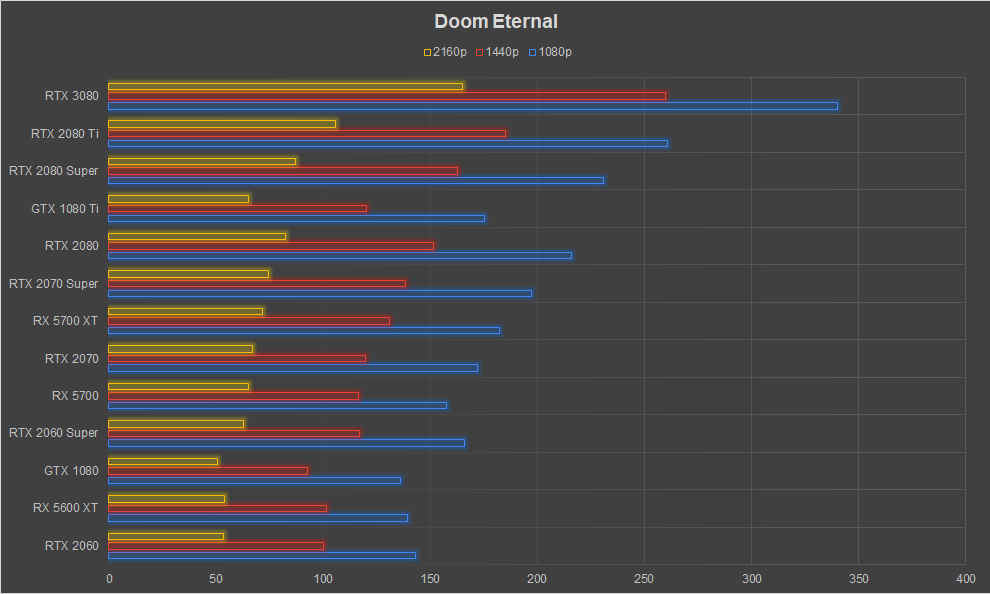
Shadow of the Tomb Raider
We run Shadow of the Tomb Raider in DirectX12 mode. It ends up consuming a little more memory as most games that support both DirectX 11 and DirectX 12. The preset is set to the highest quality and HBAO+ enabled. The ingame benchmark tool takes us through several scenes which feature open spaces as well as closed spaces with lots of world detail aside from the central character. The RTX 3080 performs about 61-67 per cent better than the RTX 2080 at 1440p and 2160p resolutions, whereas on 1080p, it ends up performing about 49 per cent better than the RTX 2080. When compared against the RTX 2080 Ti, we see the performance difference drop to about 30 per cent.
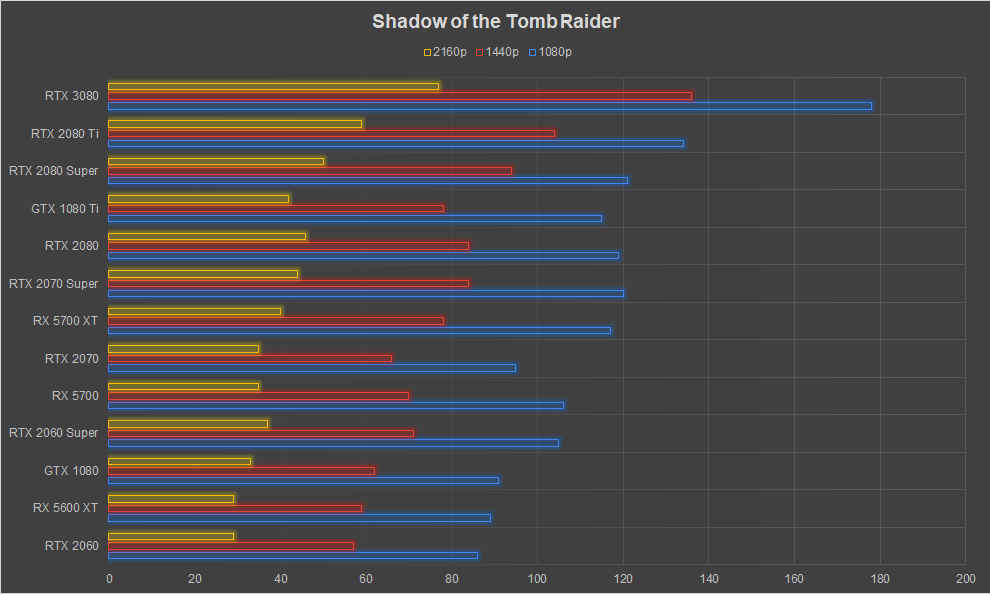
The Witcher 3
The Witcher 3: Wild Hunt is yet another game wherein we can see the generational improvements quite clearly as the game is still capable of stressing the top-end graphics cards. This seems to be changing of late as the RTX 3080 ended up getting 107 FPS at 4K with the ultra preset. We do switch off NVIDIA Hairworks in our bench runs since it’s a proprietary NVIDIA feature and that messes up the performance measurements between AMD and NVIDIA cards. When compared with the RTX 2080, we see that the RTX 3080 is approximately 74 per cent better in 1080p, 1440p and 2160p benchmarks. And when compared to the RTX 2080 Ti, which is the more appropriate comparison till it gets trumped later on, the RTX 3080 performs about 37-44 per cent better.
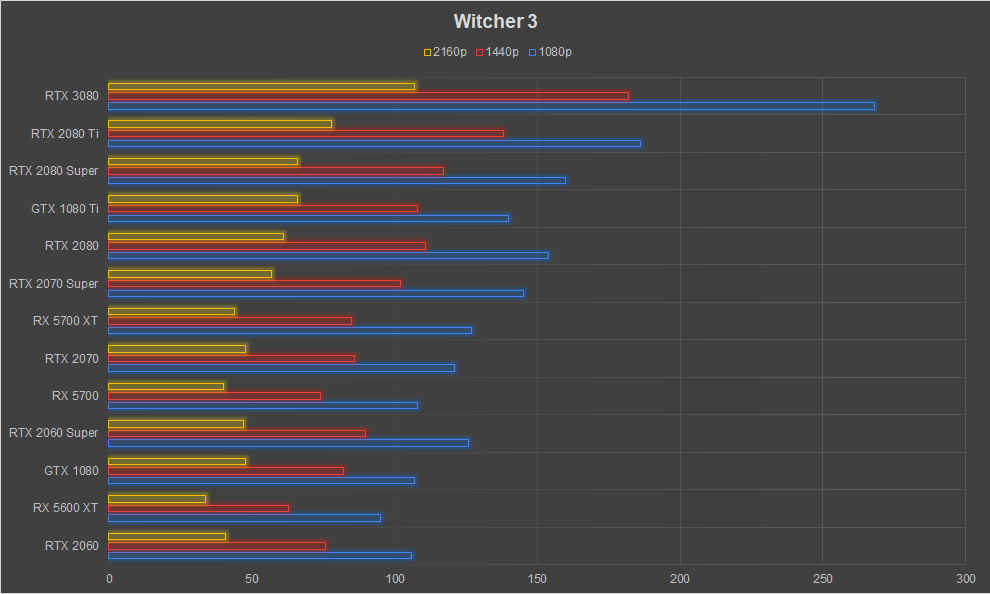
During most of our gaming benchmarks we didn't see the RTX 3080 go over 65 degrees celsius. The entire card is a massive heatsink so it has that in its favour. While cooling has been achieved, one needs to examine why such a beefy cooler was needed in the first place. In some benchmarks, we saw the RTX 3080 consume 320 watts consistently. Peak power consumption would hit 335 watts quite frequently which is a ridiculous amount for the graphics card. We're looking at the bygone era's of dual-GPU graphics cards with values such as this one. We can only imagine what the RTX 3090 would. Also, our 1200W PSU seems to have conked off in the midst of benchmarking the RTX 3080 and we had to slip in a newer 750W PSU for the rest of the benchmarks. Power consumption values remained the same with both PSUs.
The Founders Edition NVIDIA GeForce RTX 3080 will be priced at Rs 71,000 in India. The RTX 3080 and RTX 3070 pricing seem to be similar to the launch prices for their RTX 20 counterparts. Launch price for the RTX 2080 Ti Founder’s Edition was Rs 1,02,500 and the RTX 2080 started off for Rs 68,500 and lastly, the RTX 2070 was priced at Rs 51,200.
The NVIDIA GeForce RTX 3080 easily beats the RTX 2080 across all games and synthetic benchmarks by about 30-70 per cent. In some titles, it events goes ham and achieves 2x the performance. So there's little need to worry over there. It's even cooler than previous gen reference cards. So there's little reason to skip this generation. If you're looking for a flagship GPU to own, this is it. We're still going to wait for the AMD RDNA GPUS in the form of the RX 6000 series but by the looks of it, AMD has a tough job if it wants the performance crown.
| Price: | ₹71000 |
| Release Date: | 01 Sep 2020 |
| Variant: | None |
| Market Status: | Upcoming |

While not dishing out lethal doses of sarcasm, this curious creature can often be found tinkering with tech, playing 'vidya' games or exploring the darkest corners of the Internets. #PCMasterRace https://www.linkedin.com/in/mithunmohandas/











Digit caters to the largest community of tech buyers, users and enthusiasts in India. The all new Digit in continues the legacy of Thinkdigit.com as one of the largest portals in India committed to technology users and buyers. Digit is also one of the most trusted names when it comes to technology reviews and buying advice and is home to the Digit Test Lab, India's most proficient center for testing and reviewing technology products.

We are about leadership-the 9.9 kind! Building a leading media company out of India.And,grooming new leaders for this promising industry.




न्यूजट्रैक के नए ऐप से खुद को रक्खें लेटेस्ट खबरों से अपडेटेड । हमारा ऐप एंड्राइड प्लेस्टोर से डाउनलोड करने के लिए क्लिक करें - Newstrack App
Barcelona head coach, Ronald Koeman, has named a strong squad to face Girona in today’s pre-season friendly fixture at the Johan Cruyff Stadium.
Koeman released a list of 23 players to tackle the Segunda División side in a post via the club’s official website on Wednesday.
Barcelona head to the game after defeating Gimnastic 3-1 in their last fixture last Saturday.
Barcelona squad against Girona: Neto, Iñaki Peña, Arnau Tenas, N. Semedo, Piqué, Sergio, Griezmann, Messi, O. Dembélé, Coutinho, Lenglet, Jordi Alba, Braithwaite, S. Roberto, F. De Jong, Junior, Aleñá, Trincao, Pedri, Riqui Puig, R. Araujo, J. Cuenca and Konrad.
The kick-off time for the friendly match is at 6 pm.
67
71
71
73
The good looks of the Realme 1 hides the inconsistencies of the phone. It tries to get ahead of the game by gaming the synthetic benchmarks but falls flat in real world performance. It positions itself as a selfie-centric phone but the selfies from the phone comes off as artificial and puffed up.
Oppo has been a player in the Indian smartphone market for quite some time now. The China-based company, owned by BBK Electronics has positioned itself more as a premium brand in the country. Most of Oppo’s offerings have been more or less expensive with a strong emphasis on selfies. One could say Oppo’s offerings are more of a lifestyle device than just a piece of technology. However, the highest demand in the smartphone market in India is for mid-range phones that are low on price and high on features. Oppo wanted a piece of the mid-range cake, but being a premium brand, it can’t just come out with a cheap phone. Hence the brand, Realme. Just like what Xiaomi did with the Redmi brand, Realme wants to do the same for Oppo.
But whether the bet of introducing a new brand will pay off for Oppo or not is fodder for another discussion. The focus right now is whether Realme 1, the first phone under the new sub-brand is an attractive proposition. The phone certainly look different and the diamond black flair adds to the premium charm of it.
The Realme 1 launched in India exclusively to take on the Redmi Note 5 Pro, but how far does it go to settle the argument? We find out.
Design
The Realme 1 looks distinctly different from all other phones at its price, thanks to the diamond-like reflective body. The phone is housed inside a fibre-glass casing that has been cut at different angles such that each section of the glass back turns to a different shade of black when light is reflecting off it. It does look a lot like a diamond. If you like your gadgets shiny and glossy, this phone will catch your eye. The same glossy finish runs along the edges as well.

The front is all screen. There are no capacitive navigation button on the front. Even the fingerprint sensor is missing. The Realme 1 relies only on facial recognition for authentication. It’s a brave move by a brand that’s taking its first plunge in a highly competitive market, and other than just being perceived as future forward, it’s actually detrimental to the experience. The user loses out on the reliability of the fingerprint when authenticating purchases. The face unlock is quick, but isn’t reliable enough to keep user’s data secure. You can use facial authentication to access the private space (where you can store apps and data securely), and private apps (that are password-locked). In a practical scenario, the phone was unlocked by a colleague by simply pointing it at my face from a distance.
Apart from the diamond-black finish, it’s a pretty straightforward phone. It rocks the in-vogue univisium form factor and is just 7.8mm thick. There’s an ugly bulge along the edge of the phone that messes with the grip. The screen takes up most of the real-estate up front. The screen-to-body ratio is around 84 percent, which Realme managed to do by fitting the usual 6-inch display in a smaller 6.14-inch frame. The phone is offered in two more colours — Red and silver, but that will be available later in June.
Display
The Realme 1 sports a standard-issue 6-inch Full HD+ display of 18:9 aspect ratio. The panel is just about average with decent colour reproduction. The colour tones are slightly on the cooler side and brightness isn’t high enough to be visible properly when outdoors. In fact, there’s some colour loss at peak brightness and texts appear faded under direct sunlight. The panel quiet reflective too. You get the usual blue-light filters and options to tweak the colour temperature.
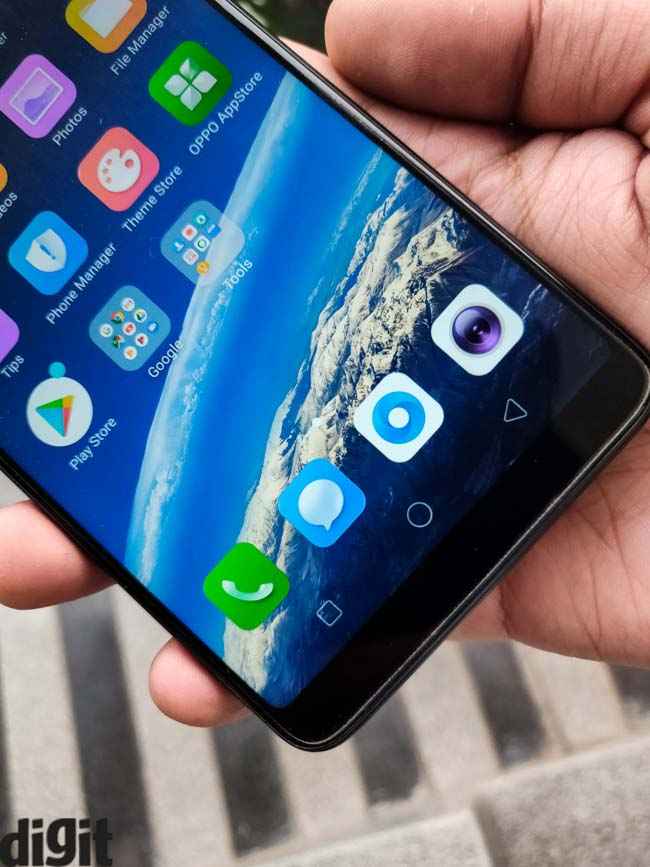
The good part about the panel is that it takes up most of the real estate up front with minimal bezels on the top and the bottom. The sides are also quite thin, which gives off an immersive feel to the content.
Performance and UI
The Realme 1 wants to be the phone of choice for mid-range buyers. The undercutting price point is one instance where it shows. But more than that, it’s the brand’s attempt to beat the best in its maiden attempt that brings out the competitive attitude of the company.
The Realme 1 is powered by the MediaTek Helio P60 SoC which is MediaTek’s most advanced chipset. It comes with an AI chip inside that can compute machine learning tasks on the device itself. It is what powers the facial recognition and the battery efficiency, apart from other things. It’s an octa-core chipset built on a 12nm FinFET process with four Cortex A53 and four Cortex A73 cores, all clocked at 2GHz frequency. On paper it’s faster than its Qualcomm counterpart, as the benchmark results from AnTuTu 7.0 and Geekbench will state. However, when I monitored how the chipset was being used, I observed some anomaly. It seemed for both the benchmark tests, which is comprised of multiple small tasks that stress the CPU to measure performance, the chipset was running at a constant 2.0GHz, irrespective whether the load on the CPU was minimal or at its peak. It could either be an anomaly with the unit I received or Realme is gaming a popular benchmark tests. In a more real world scenario, when the performance was measured while playing the new PubG Mobile game, the CPU speed matched the load put on it. The AnTuTu score for the Realme 1 was 138260 against the Redmi Note 5 Pro’s 112652. The Geekbench Single Core and Multi Core scores are also higher at 1490 and 5682 respectively. But in both cases, the CPU was artificially plonked up to eke out a better score.
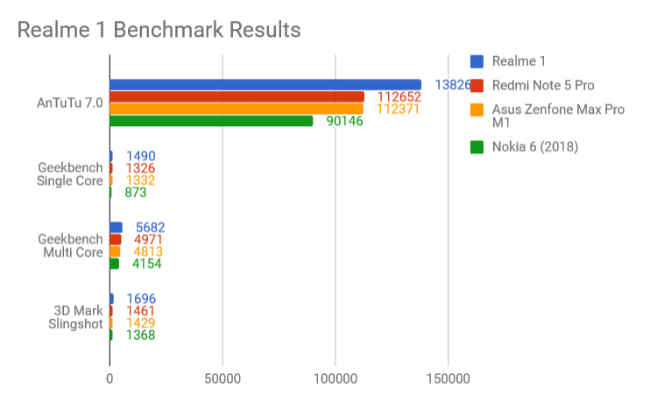
We performed a similar analysis on the Redmi Note 5 Pro which proved to be more consistent in responding to CPU load both during synthetic benchmark tests and real world scenarios. The Realme 1’s anomaly seems a little too deliberative. Nevertheless, there’s 6GB RAM and 128GB storage on the unit we re. It leaves enough resources free despite a heavy user interface. It also support dual VoLTE which is useful in the Indian context.
The Realme 1 relies on Oppo’s Colour OS. It’s definitely functional like all Android-layered user interfaces these days, but I wouldn’t call it particularly appealing. It lacks the attention to detail that MIUI is known or the simplicity of stock Android. Instead, the UI seems cluttered with disproportional icons and overall looks quite cartoonish. It does come with a game mode, a private space and the usual bells and whistles of Android Oreo, but that doesn’t take away the fact how uninviting the UI looks for a nitpicking user.
Camera
The fate of smartphones these days is decided by how good the camera is. The Realme 1, in that section, is quite underwhelming in comparison to the competition. It has a single 13-megapixel sensor at the back while on the front is an 8-megapixel shooter. The focus, unsurprisingly, is on selfies and portrait shots. The phone relies on Oppo’s AI algorithms to fine-tune the photos which the company claims works by analysing 296 recognition points to understand the skin tone, age, gender, etc. Based on that analysis, the phone applies one of 8 million ‘beauty solutions’ to the image.

The end result is simply a photo with extreme layers of softening, so much so, that all spots and blemishes are hidden. It was a tad difficult for me to accept the effects, but I suppose there’s a demand for them in a country where fairness creams are one of the highest selling products. If beautification is what you’re seeking from a smartphone camera, the Realme 1 will be a pure delight. But if you’re a little more serious about taking good photos, the phone might leave you hanging.
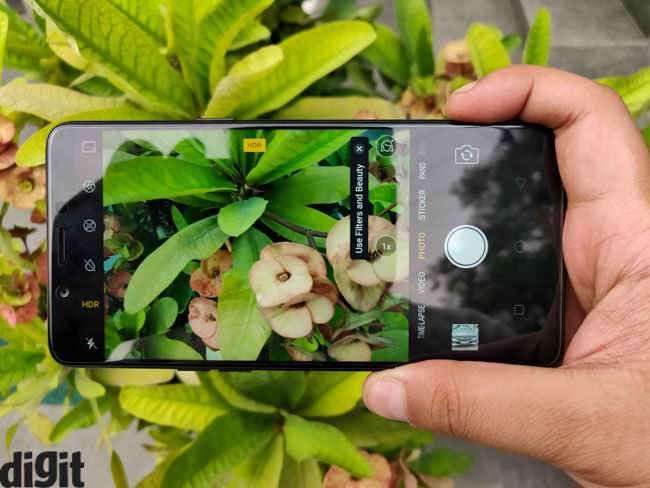
In daylight, the photos have ample highlight clipping. There’s practically no detail in the bright sky in the photo below. Furthermore, the camera tends to saturate the colours more than they are in reality. It also lacks the desired dynamic range.

Indoor shots are a little more polished. The controlled light brings out the good side of the camera. There’s more controlled AI enhancement and the little that it does, it makes objects look much better than they are in real. You get good sharp images with a slightly warmer white balance. There’s some glare off the source of light though, which might be a lens issue.
Under low light, the camera fails to show much promise. Grains show up if you try to dial the exposure higher to take an image under poor lighting, with little to no detail. The shutter speed is actually dialled up when there’s less light which demands a steady hand and if the object is moving, you get a blurred photo.
The portrait mode is present both on the front and the back camera. The Realme 1 relies on software to simulate the depth-of-field effect. It’s nowhere as consistent as the Redmi Note 5 Pro, but it does the job as far as blurring the background is concerned.

Battery
The Realme 1 is powered by a 3410mAh battery. For those comparing, that’s a hairline more than what Xiaomi’s best mid-range phone offers, and the battery life of the phone is more or less at par. The phone managed to run for 6 hours on the PCMark Battery 2.0 Test which should easily convert to over a day’s usage for an average user. For the review, I used the phone to browse the internet, play games, take photos and use social media. It did last me for a typical work day and then some more. The Helio P60 chipset seems to be quite energy-efficient and based on the battery life, Realme seems to be delivering on its promise of using machine learning to manage resources. The battery section in the Settings app gives some insight in how much juice each app takes and apart from the resource-intensive game I was playing, the UI sucked up most of the battery. When you are running out of power on this phone, you know what to blame.

Bottomline
The debutante Realme 1’s ambition to compete with the likes of Xiaomi Redmi Note 5 Pro is quite apparent. It looks boldly different from the rest, but a good design will only take it so far. The performance is nowhere near the best in the market, despite the benchmark results telling you so. The camera which is propped up by on-device machine learning ends up delivering unnaturally softened photos while the UI comes off quite amateurish. The battery life is the only saving grace, but overall this phone isn’t what it advertises to be. Oppo’s decision to come out with a new sub-brand to cater to the highly competitive mid-range market may be driven by consumer demand, but there’s little in the phone to entice buyers, apart from a good looking device.
| Price: |
 Rs. 10999
Rs. 10999
|
| Release Date: | 25 May 2018 |
| Variant: | 32GB , 64GB , 128GB |
| Market Status: | Launched |
 Screen Size
Screen Size
 Camera
Camera
 Memory
Memory
 Battery
Battery

Digit caters to the largest community of tech buyers, users and enthusiasts in India. The all new Digit in continues the legacy of Thinkdigit.com as one of the largest portals in India committed to technology users and buyers. Digit is also one of the most trusted names when it comes to technology reviews and buying advice and is home to the Digit Test Lab, India's most proficient center for testing and reviewing technology products.

We are about leadership-the 9.9 kind! Building a leading media company out of India.And,grooming new leaders for this promising industry.

 Tamil Nadu CM Edappadi K Palaniswami
Tamil Nadu CM Edappadi K Palaniswami 
Raj Kapoor with his granddaughters
Bollywood actress Kareena Kapoor Khan took to social media to share an unseen throwback picture from her and Riddhima Kapoor Sahni's childhood with grandpa Raj Kapoor as Riddhima turned 40 on September 15. Sharing the picture, she wrote, “Sister sledge. Happy birthday beautiful Ridz @riddhimakapoorsahniofficial (sic).”
In the picture, little Bebo and Riddhima can be seen sitting in grandpa Raj Kapoor’s lap while Karisma can be seen hugging him. As the picture refresh their childhood memories, Riddhima was quick to drop a comment to Bebo’s post and wrote, “Aww thank you Bebo. @KareenaKapoorKhan love you (sic)."
This adorable throwback picture gives a glimpse of sisters’ strong bond that they have been sharing since their childhood. Karisma also reposted the same picture with a witty caption. She wrote, ”Bebo can you please wake up? Oh that goes for me too #family #Repost (sic).”
The actress also shared a couple of photos with Riddhima on Instagram and wrote, "Happy 40th birthday! so glad we got to celebrate with you! @riddhimakapoorsahniofficial #birthdaywishes #family #cousins #happybirthday #familytime (sic)."
Karisma and Kareena also shared pictures from the celebration on their Instagram stories. The Kapoors gathered at Neetu Kapoor’s house to celebrate Riddhima’s 40th birthday. Bebo’s husband Saif Ali Khan and Ranbir Kapoor’s girlfriend Alia Bhatt also joined the celebration.
Riddhima is showered with love and best wishes from family and friends. Several other Bollywood celebs also took to social media to wish the birthday girl.
Meanwhile, Bebo is also gearing up for her 40th birthday in the coming week on September 21. It seems like this month is going to be the birthday month for Kapoors.

File image of Kim Kardashian.
As much as we love Facebook and Instagram for connecting us with our favourite actors and influencers, we cannot ignore the fact that the social media has been giving a platform to hate speech and misinformation also. To urge Facebook to reform its policies against hate speech, celebrities like Kim Kardashian, Jennifer Lawrence and others are going to quit social media for a day under the #StopHateForProfit campaign.
Facebook ignores hate & disinformation on their site. This is not an “operational mistake.” It is a deliberate decision to put profits over people and democracy. Tell Facebook to #StopHateForProfit. https://t.co/7TSovLMug2 pic.twitter.com/lJts6Ampgp
— Jennifer Lawrence - Represent.Us (@JLawrence_RepUs) September 14, 2020
Actors like Sacha Baron Cohen have joined forces with the Anti-Defamation League (ADL) to launch the campaign calling on Facebook to crack down on hate speech, violence, and misinformation on its platforms. In one of its recent tweets, ADL said, “Facebook does not protect its users from hate or disinformation. Facebook has shown us time & time again that profits come before people. That’s why we are “freezing” our Instagram account for 24 hours.”
The only thing more terrifying than Mark Zuckerberg surfing in whiteface...Is the white supremacy and lies Facebook spreads every day. This Weds Sept 16 I’m freezing my Instagram to tell Mark to #StopHateForProfit. Who’s in?! pic.twitter.com/nM5VB9YVZd
— Sacha Baron Cohen (@SachaBaronCohen) September 14, 2020
Facebook does not protect its users from hate or disinformation. Facebook has shown us time & time again that profits come before people. That’s why we are “freezing” our Instagram account for 24 hours.Join us & send a message to Facebook to #StopHateForProfit. pic.twitter.com/84n9dAx9WB
— ADL (@ADL) September 16, 2020
The "freeze" is part of the campaign’s "week of action”, which kicked off Monday. Members plan to continue to share information on "how Facebook’s failures lead to real-life violence and sow division" and call for change through the end of the week.
Businesswoman and social media influencer Kim Kardashian also urged Facebook to stop providing platform to hate speech which is dividing America. She tweeted, “I can’t sit by and stay silent while these platforms continue to allow the spreading of hate, propaganda and misinformation - created by groups to sow division and split America apart only to take steps after people are killed. Misinformation shared on social media has a serious impact on our elections and undermines our democracy.”
I love that I can connect directly with you through Instagram and Facebook, but I can’t sit by and stay silent while these platforms continue to allow the spreading of hate, propaganda and misinformation - created by groups to sow division and split America apart pic.twitter.com/XkxzABn7qw
— Kim Kardashian West (@KimKardashian) September 15, 2020
Actor Mark Ruffalo has also called on Facebook to take substantial steps to stop hate speech, misinformation on its platform and has frozen his accounts this Wednesday.
Facebook claims they address hate, yet they continue to look the other way as racist, violent groups and posts sow division and split America apart – only taking steps after people are killed. (1/2) pic.twitter.com/AfO70nEEo8
— Mark Ruffalo (@MarkRuffalo) September 14, 2020
Thank you to @michaelb4jordan @iamjamiefoxx @LeoDiCaprio @kerrywashington @KimKardashian @NaomiCampbell for calling out Facebook for ignoring hate & disinformation on their site. This is not an “operational mistake.” It is a deliberate decision to divide.#StopHateForProfit pic.twitter.com/lI1P5kQus6
— NAACP (@NAACP) September 16, 2020
With the US Presidential elections just a month away, social media platforms have become an essential platform for politicians and other interest groups to target its voters and influence the election results. The political scene in the United States has been polarised since President Donald Trump took office with some help from Facebook as explained by Netflix documentary The Great Hack. The recent Black Lives Matter protests and President Trump’s ways of curbing it have only raised questions on social media companies' responsibility in tackling fake news which can endanger marginalised people’s lives.
India 500
Worldwide 10000
India 1500
Worldwide 60000
India 9000
Worldwide 89000
Rimini Street Statement on Court Ruling on Motions for Partial Summary Judgment
Rocking Superstar, YASH Picks EXCEED Entertainment for Bollywood Representation
Power Integrations Targets Compact Smart-Lighting Designs With Highly Efficient GaN-Powered LYTSwitch-6 LED Drivers
Alibaba Unveils New Manufacturing Digital Factory
Bentley Systems Announces Launch of Initial Public Offering
New Optimum® Class VI Dispensing Components Provide Assurance to Medical Manufactures
For quite some time, a piece of news showing India has 21 million jobless has triggered fear in the minds of those who still retain their purse. Those who lost their salaries have blamed it on the prevailing pandemic. But when the virus was absent, a strange activism had prevailed across India, ensuring some of the largest businesses remained shut across the country, and some of the Indian companies working abroad drew flak.
Jobless workers protest in Goa to reopen iron ore mines
So let’s take a quick look.
Work has stopped in the iron ore mines in Goa, one of Asia’s largest copper plants has shut down in Thoothukudi in Tamil Nadu, troubles are brewing in iron ore mines in Chhattisgarh and Odisha and at the Adani group’s coal mines in the Down Under. Strangely, these have become disturbing symbols of the Indian industry.
All has come at a cost to the economy, imports have increased and exports taken a tumble.
At the heart of this are protests by a handful who have hopped, skipped and jumped from one protest to another, ensuring they generate the much needed steam to their movement. One movement has died, another risen like the proverbial Phoenix from the ashes. These activists have routinely raised India’s big issue of land versus machines and cried wolf, smoking out everything else from the horizon. They are not worried about a lakh of miners going jobless and hungry for over two years in Goa. They do not care about 35,000 struggling without salaries in Thoothukudi, or, for that matter, Indian companies piling up huge non performing assets in the mines of Chhattisgarh, Odisha and Jharkhand. Like Bengal’s ubiqutious Cholbey Na slogan in the 70s that killed industry in that eastern Indian state, these activists have continued their activism for a very long period.
What is surprising is their claim to fight for people’s rights when these rights are actually nowhere in sight. There is a common thread of people who are omnipresent in all these protests, their frustration seems both natural and common. They want the world to believe that India is burning, Indian companies are dubious, the world’s second most populous nation is in a revolutionary mood.
Last week, a Dubai-based activist campaigning against Adani’s coal mines in Australia, mistakenly revealed how he planned to scuttle Adani’s operations through an email that got leaked. In the email, the activist had apprised his friends in Australia about his plans to set up a website and create trouble for the Ahmedabad-based Indian conglomerate which runs business ranging from infrastructure to airports to ports to edible oil.
The activist’s Dubai to Australia connection to discredit an Indian company is interesting, especially at a time when jobs are at a premium and a closure would mean further catastrophe. The activist was seeking help from an anti-Adani group in Australia. Helping him were activists in India who have been in the forefront of the anti-Sterlite movement in Tamil Nadu, and against mining companies in Odisha, Jharkhand and Chhattisgarh.
Iron ore, coal and copper do not jell together but the broad idea was to add an Indian twist to build up a narrative of alleged wrongdoings in India and get it amplified in Australia. Or, for that matter, across the world. Recently, these activists raised another hue and cry over India’s coal mining and argued why it could not be substituted by solar or wind energy. Little did they realise that coal – under any circumstances – could not be replaced overnight, it still remains the best possible resource for energy in a billion plus nation. Conspiring activists are challenging the energy security of the country where per capita electricity consumption is just about 1200 units a year compared to China with four to five times higher numbers.
Those criticising India and its energy policies forget the developed nations have per capita electricity consumption is as high as 10000 to 20000 units. Little did they care that their misplaced activism could affect the Indian economy, disrupt growth opportunities & reduce scope of employment badly. They did not care that projecting one conglomerate with negativity would diminish another Indian conglomerate’s chance for inter-continental projects Indian companies are eyeing in a post-Covid situation. They seem to be keen on building an overall negative perception globally that Indian corporates care little for environment and human rights and also the rights of tribals and indigenous peoples. They do it knowing very well that their actions would help create an anti-Modi sentiment across the Indian borders.
What is interesting is that the majority of these protests are against large private firms and happening in a selective manner. For instance, Adani Group does not own any mine in India and it is a contractor for state owned mines. However, all energy and attention of so called activists is targeted to a contractor producing 15 million tonne a year for a state utility instead of the world’s largest coal mining firm, the Kolkata-based Coal India Limited (CIL) just because it is a public sector undertaking. The big race for breaking headlines in India often misses the real picture.
Surprisingly, none of these environmental activists ever hit the print industry that also claim millions of trees to produce newspapers. Worse, industries in India have often expressed their concerns over blackmailing by activists by misusing or manipulating media.
So let’s take a look at the protests against Adani. There is a peculiar pattern spotted in protests against the likes of Adani where Indian activist lobby is supporting protests in Australia, which is the world’s largest coal exporter with well over 25 percent market share. Indian activists have never expressed concerns against CIL or other Australian mining entities. Singling out one from a cluttered market creates suspicion. It would not be wrong to say interests of Australian activists started in Carmichael mine generated only after it was acquired by Adani from an Australian mining entity.
So why is this happening?
There is some deep-rooted economics of this activism. If there are Cola giants, they need to be linked to water crisis (never mind if the demand to ban the soft drink majors comes from faraway Norway), if there is iron ore or coal, the mining companies need to be blamed and if there are airports and ports, infrastructure giants need to be hauled over the coals. On paper, these activists lace their work with a tinge of environmental activism. It is all about some interesting twists and turns, it is about deferring current consumption for a better and secure tomorrow. They tell the world that if companies pollute rivers and cut forests for mining, the coming generations will get nothing on plate.
That is a great argument, a great platform for breaking news that is considered both dangerous and madness by many in South Asia. The world loves visuals of an impoverished tribal standing tall with his father’s machet against miners seeking to break the earth for iron ore, or coal. It is a great photograph of protest, students love to flaunt it to their parents, and friends. It is the best form of defence, there is no economics of scale involved.
But these self-styled mass movements for environmental causes actually come packaged without a reason. It is like asking the poor – who is at the rock bottom of the economic ladder – to kill industry and defer consumption. In most cases the poor back out, and these movements die a silent death.
A serious look at activism in India will show an interesting trend. Ever since the Supreme Court gave approval in October 2020 to the Sardar Sarovar Dam project in Gujarat, activists shifted their gears in favour of rights, ranging from land, homes, food, information and health. They did not care, did not realise that a nation’s resources are best saved when the government blends a lot of economics in its decisions and achieves a balance. They should have taken a lesson or two in economics from India’s lost decade (2004-14) before hyperventilating on corporate greed.
The need of the hour is to generate jobs, not protests. Activism must be laced with realism. Else, the jobless will spill out on the streets. And that would be dangerous for the nation, and its economy.
82
87
63
74
With the Galaxy Note 5, Samsung has completed the transformation it started with the Galaxy S6 this year. The phone is a combination of power and design, and not many would deny that the phone looks good and performs well. It’s pure style, combined with good performance. The only real hitch is that a phone this expensive shouldn’t be prone to falling out of your hand. If you’re looking for a flagship phablet, then this is still the one to buy though.
Having reviewed three out of four Samsung flagships this years, there’s not much left to say about the Galaxy Note 5 that we haven’t said in those other reviews already. What differs though is that The Samsung Galaxy Note 5 has much more to live up to than the other devices. This is a segment that Samsung pioneered, which means that the responsibility of innovating falls on its shoulders. Evidently though, the company’s focus this year is on design, because that’s precisely where the Note 5 is different from other Note devices till now.
Build and Design
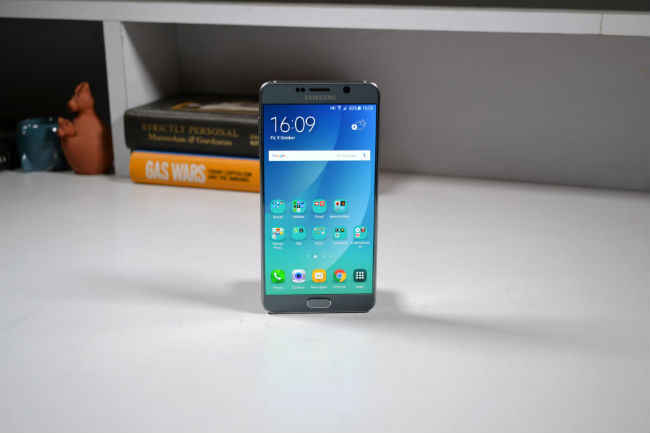
The glass and metal design philosophy that Samsung adopted for its flagships, continues with the Note 5. The phone has curved glass on the back and a sheet of Gorilla Glass 4 on the front. But you already know about that.
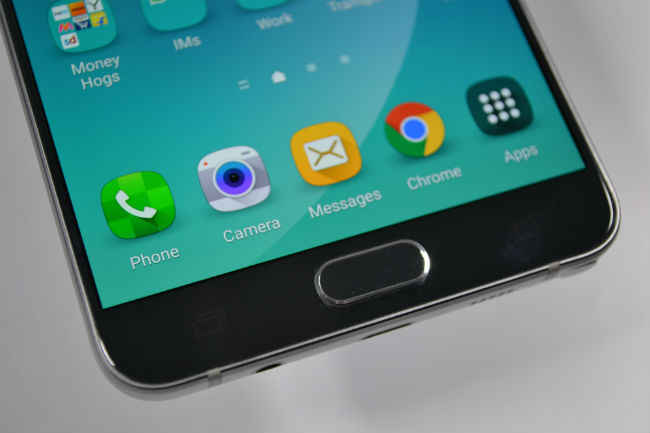
What you need to know is that while the Note 5, like the Note 4 before it, is more compact than other phones in this series, it remains unwieldy. Many seem to like this large size though, so the decision falls on the buyer. The heavy usage of glass though makes the phone really slippery and prone to falling out of your hand.
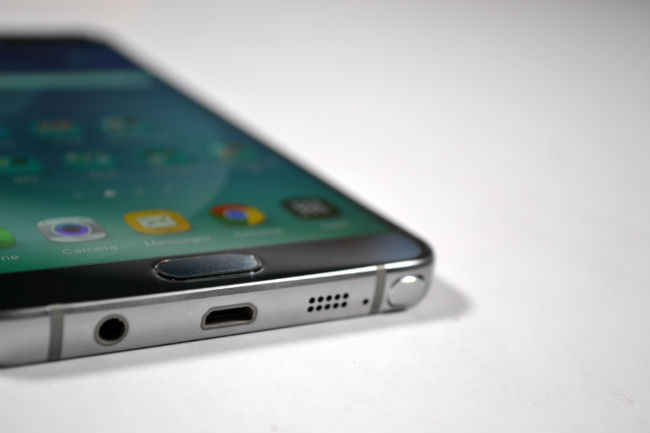
None of that changes the fact that the phone looks premium though. The curved glass on the back has but one job, and that is to make this phone look good and different. From the front though, it’s a quintessential Samsung design, and whether you like it is completely your own opinion. For us, we would give Note 5 a lot of marks on the looks front.

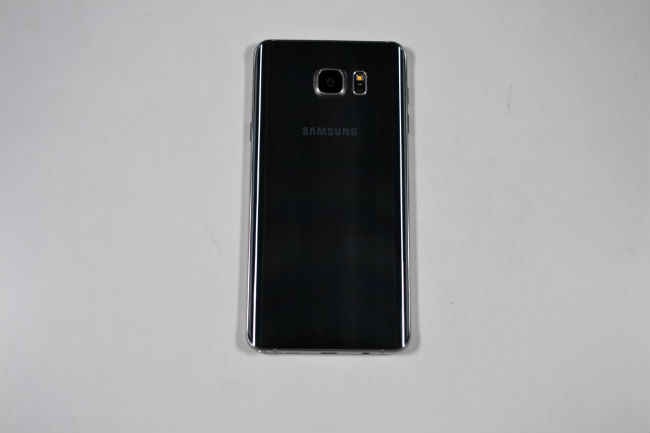
Display
If you’ve read out Galaxy S6 Edge Plus review, you already know how good the Note 5’s display is. The 5.7 inch QHD SAMOLED display is one of the best out there. What’s interesting is that Samsung has toned down the yellowish-ness of the display. The Galaxy S6 Edge has a pretty warm display, to the point that it looks like the odd one out when placed next to an LG G4 and Sony Xperia Z3+, but the Note 5’s display is not as warm as we’ve come to expect from Samsung.
Colours are really vivid on the display, and if you’ve liked Samsung displays till now, this one’s to die for, just like the S6 Edge Plus.
Watch Video
S-Pen
The S-Pen on the Galaxy Note 5 is as good as it ever was, and a tad better. That said, even with a 5.7 inch display, there's only that much that you can do. If you've been a big proponent of Samsung's S-Pen though, then the one on the Note 5 is easily the best till now. It writes almost like a real pen and Samsung has added the option to add apps to the Air Command menu. So, you can now add apps like Evernote, OneNote and others to the Air Command menu and write on them using the S-Pen. What's more useful though is the Screen Off Memo option, which allows you to write with the S-Pen even with the display turned off. Whenever you pull the S-Pen out of the Note 5, the screen will remain black, but you can write on it and jot down a few notes. It's limited in the sense that there's only that much you can write on a 5.7 inch display, but its pretty useful nevertheless.
Lastly, and perhaps most importantly, the Galaxy Note 5 can alert you if you've left the S-Pen behind somewhere. This perhaps is something that every Note user would appreciate, considering how many have lost their styluses. The S-Pen Alerts option is turned on by default and you can turn it off from the Settings menu.
Performance
Benchmarks don’t ever suffice for performance testing, but Samsung’s got both the aspects covered with its Exynos 7 Octa processor. This is the same processor that runs on the Galaxy S6, S6 Edge and the S6 Edge Plus.
In regular usage, the Galaxy Note 5 can take anything you throw at it, and the bigger size of the phone, allows for better heat circulation, allowing the average clock speed to remain higher than in the Galaxy S6 and S6 Edge. The performance of the phone can’t be credited to the SoC alone though. While Exynos 7 is a good processor, the Note 5’s performance owes a lot to the fact that Samsung has made no compromise. The sequential read speeds for the storage on the phone come to around 440 MB per second which for the general public, translates to really good. In addition, DDR4 RAM allows the performance to be even smoother, and 4 GB of it, allows for a lot of multitasking.
The overall performance of the Note 5 is a combination of processor, NAND and RAM, and they all do well working in unison. It’s the best performing Android phone in the market right now, speaking in terms of pure performance. Even the call and network performance on the Note 5 is better than others. In a room with 5 people on the same Vodafone network, the Note 5 can get a 3G signal even when others are stuck on Edge. This is something that many iPhone users report about their devices.
It would be worth mentioning that the Galaxy Note 5 sends diagnostic reports to Samsung servers whenever it's connected to a WiFi. You can turn this off from the Settings Menu, by going into Lock Screen and Security. I have contacted Samsung to clarify that the Reports are indeed only diagnostic reports, and am yet to hear back from it.
Battery
All the performance though, usually take a toll on the battery life, so when Samsung allowed a 3,000 mAh battery, I was somewhat disappointed. You’re talking about a 5.7 inch QHD display here, along with a powerful octa-core processor.
Here again though, the Note 5 exceeded expectations. On a regular work day, with exactly 26 phone calls, lots of IMs, social networking and about 20 minutes of gaming, at midnight, the phone had 15% of battery left. This is without using the battery saver mode at all, and that’s about as good as any phone in the market can give you today.
Camera
We’ve discussed Samsung’s prowess with cameras in the Galaxy S6 Edge and S6 Edge Plus review, so we’ll simply direct you to those for this one.
Bottomline
With the Galaxy Note 5, Samsung has completed the transformation it started with the Galaxy S6 this year. The phone is a combination of power and design, and not many would deny that the phone looks good and performs well. It’s pure style, combined with good performance. The only real hitch is that a phone this expensive shouldn’t be prone to falling out of your hand. If you’re looking for a flagship phablet, then this is still the one to buy though.
| Price: |
 Rs. 29999
Rs. 29999
|
| Release Date: | 15 May 2017 |
| Variant: | 32GB |
| Market Status: | Launched |
 Screen Size
Screen Size
 Camera
Camera
 Memory
Memory
 Battery
Battery

Digit caters to the largest community of tech buyers, users and enthusiasts in India. The all new Digit in continues the legacy of Thinkdigit.com as one of the largest portals in India committed to technology users and buyers. Digit is also one of the most trusted names when it comes to technology reviews and buying advice and is home to the Digit Test Lab, India's most proficient center for testing and reviewing technology products.

We are about leadership-the 9.9 kind! Building a leading media company out of India.And,grooming new leaders for this promising industry.


Shruti Modi reached Narcotics Control Bureau's office in south Mumbai today for questioning
A member of the Narcotics Control Bureau (NCB) team probing drugs angle in actor Sushant Singh Rajput's death case has tested positive for coronavirus on Wednesday following which questioning of the actor's former manager Shruti Modi has been postponed, an official said.
Shruti Modi reached the NCB office in south Mumbai around 10 am for questioning by the Special Investigation Team (SIT).
But, before the probe team could start recording her statement, the NCB received report of one of its SIT members testing positive for coronavirus, the official said.
The SIT member's antigen test came out positive, he said, adding that other members of the probe team will also be tested and all protocols will be followed.
"Accordingly, we sent back Shruti Modi who had joined the investigation in the morning," he said.
The NCB on Tuesday asked Shruti Modi and Sushant Singh Rajput's talent manager Jaya Saha to join its investigation to get a better picture on some aspects of the case. Jaya Saha will now be called later, the official said.
So far, the top drug law enforcement agency has arrested 18 people, including Sushant Rajput's friend and actress Rhea Chakraborty and her brother Showik Chakraborty.
Earlier, statements of Shruti Modi and Jaya Saha were recorded by the Central Bureau of Investigation (CBI), which is separately probing the Sushant death case.
They were also questioned by the Enforcement Directorate (ED) and the Mumbai Police in connection with cases linked to the actor's death probe.
Chats of Jaya Saha with Rhea Chakraborty had come to light during the ED's questioning, the official added.
Sushant Singh Rajput (34) was found hanging in his flat in Mumbai's suburban Bandra on June 14.